

8 Common Reasons Your Hot Tub is Tripping the Breaker
If your hot tub has suddenly quit working, it is likely a sign that the circuit breaker tripped. Tripping the breaker is a common issue with hot tubs and, fortunately, quite easy to solve. If you’re unsure what to look for when identifying a tripped breaker, have no worries! Today, we’ll explain the 8 common reasons your hot tub is tripping the breaker and how to solve it.
Common reasons for a hot tub to trip the breaker include the following list:
- Worn GFCI breaker
- Moisture exposure
- Damaged/loose wiring
- Short circuit
- Malfunctioning element
- Flooded Ozonator or blower
- Electrical component issue
If you want to learn how to solve these issues, read on! Below, we’ll cover everything you need to know about why your hot tub is tripping the breaker and how to fix it.
1. Worn GFCI Breaker
One of the most common reasons for a hot tub breaker to trip is that it is simply worn out. Old age, power surges, and a lightning strike are just a few reasons why your ground fault circuit interrupter (GFCI) breaker is tripping.
To identify a worn GFCI breaker, flip the switch off and on. If it does not turn on immediately after shutting off, it could be a rusty or defective switch. You may consider using an electric meter to test any power coming to the circuit breaker. If there is no current being transferred from the switch when turned on, the breaker likely needs replacing.
One final option for identifying a worn GFCI breaker is disconnecting everything from it. If the breaker continues to trip even with the hot tub and all other connections disconnected, the breaker is damaged. In this case, the best option is to replace it.
2. Moisture Exposure to the Hot Tub Breaker
Another reason a hot tub breaker may be tripping is because of moisture in the breaker box. Because water cannot be present across the circuit, any moisture on the live or neutral connections will cause the breaker to trip.
Eventually, the moisture inside the breaker box will cause damage to the electrical components. As a result, the electrical components will rust, causing it to arc and ultimately trip the breaker. The best way to prevent excessive moisture from damaging the hot tub breaker is to check that the box is well sealed. It is especially important to have a rubber seal on the holes used for the cable.
For hot tub control boxes with moisture trapped inside, take a towel and dry the inside of the breaker box. From here, turn on a fan or dehumidifier near the breaker box. Once the control box is dry, reset the breaker. If this fails to solve the issue, it may be a sign that there is a problem in the circuit or that the breaker needs replacing.
If the breaker is encountering water and moisture often, you may need to replace the receptacle. Additionally, you may want to move the hot tub farther from the breaker to ensure hot tub water isn’t exposing moisture to the circuit.
3. Damaged or Loose Wiring
In some cases, hot tub breakers may trip because there is loose or damaged wiring. A wiring short, burnt wires and loose connectors are common reasons the breaker may be tripping. To identify loose or damaged wiring, look inside the breaker box and spa cabinet for any breaks or worn areas of the component wiring. Additionally, make sure all connections are secure.
Burnt Wires
As you examine your breaker box and spa cabinet, it’s important to look for any melted insulation or blackened spots on the wiring. Because burnt wiring can quickly create a fire, burnt wiring should be fixed as soon as possible.
If the wiring is old, there is likely a chance it has burnt spots or melted rubber coating surrounding the wire. In addition, hot components and component fires can destroy the wiring, leading to burnt wires. To identify burnt wires, you will need to shine a flashlight inside the breaker box and spa cabinet. Carefully examine the breaker box and cabinet for any damaged wiring.
If you notice any blackened spots, it’s important to replace the damaged wiring. Furthermore, you’ll want to identify what caused the wiring to become hot in the first place. Once you’ve identified the issue, you may repair the damaged area, or hire a professional to do it for you.
Wiring Short
A common reason for a breaker to trip is that there is a surge of power. This power surge is often caused by two wires touching each other when they’re not supposed to. It can also occur when a hot wire touches a ground wire. In addition to tripping the hot tub breaker, a wiring short may eventually start a fire.
There are a number of reasons a wiring short may occur. Perhaps you’ve recently moved your hot tub, or maybe you’ve done maintenance to the spa cabinet. Pests can also cause damage to the wiring of the hot tub breaker.
To find the offending wires, disconnect all hot tub components while flipping the breaker each time you plug them back in. When the breaker trips, you will have found the issue. Begin inspecting the wiring of the component for any damage. In some cases, the wire may simply be loose, which caused the two wires to touch. The solution for such a case is fairly easy. Either you or an electrician may reconnect it and reset the hot tub breaker.
Oftentimes, two wires may be touching because the wires are damaged. Chewed wires by pests is a common issue with hot tub breakers. If this is the case, you will likely need to replace the wires and connectors.
Loose Connections
When a hot tub breaker begins tripping, it may be a sign of loose connectors. Wiring connectors may become loose if you’ve moved or repaired the hot tub, or if the wiring is old. Even if the wires are barely loose, the electrical circuit may be interrupted, causing the breaker to trip.
Fortunately, fixing loose connections is an easy process. You will likely need to use a screwdriver to tighten the screws that keep the wires in place. In some cases, it may simply be the plastic plug-style connectors that are out of place. To fix them, firmly push the connectors until they are tight.
If the wires are old, you may find damaged connectors or even burnt wiring. If there is any damage to the wires, they will need replacing right away to prevent further damage.
4. Hot Tub Corrosion
If your hot tub is tripping the breaker, it may be because the hot tub’s components are corroded. Corrosion is a common issue with hot tubs that, without proper attention, may affect the water chemistry and create issues with the breaker box.
You may notice corrosion near the hot tub GFCI, as well as around the hot tub’s components. To find the area corroded, you’ll need to inspect the inside of the spa cabinet and breaker box. Generally, corrosion can easily be identified by its whitish powder or rusty appearance. Most likely, corrosion will occur around component connectors. This may include wire connectors, ground wires, the control panel, and any other wiring of the hot tub’s components.
To repair the corrosion, you will need to use a wire brush or electrical contact cleaner to clean the corroded connectors. Afterward, you will simply reconnect the wiring. If the corrosion is extensive, you may need to replace the wiring. Additionally, if a leak caused the corrosion, you will need to repair the leak inside the hot tub.
5. Short Circuit
Because breakers are designed to trip in the event of a short circuit, short circuits are a common reason for hot tubs to trip the breaker. Short circuits may occur anywhere electrical parts are wet or wiring is loose. Thus, it is important to keep the wiring dry and connectors tight.
If the hot tub’s control system becomes wet, it will likely cause a short circuit to occur. Always make sure the control system, as well as the breaker box, is completely dry and properly sealed. If there is any moisture inside, use a towel and fan to dry it.
Another reason for a short circuit to occur is that the connections are loose. Tightening wires can easily be done by using a screwdriver to tighten the connections. If the connections use plastic plug-style connectors, push them until they are firmly in place.
As previously mentioned, always replace a faulty wire or any connections that appear damaged. If unsure which components are causing the short circuit, unplug them and one by one plug them back in. When the breaker trips, examine the component until you find the damaged area.
6. Malfunctioning Heating Element
In order for hot tub water to become hot, the water must pass through the assembly housing and into the element coil. This coil generates heat, consequently making the water hot. When this heating element malfunctions, it will cause the breaker to trip.
You may notice the heating coil malfunctioning if the hot tub water isn’t heating up. However, the best way to determine a bad heating element is to carefully examine the element and find the cause for the breaker tripping.
Bad Heating Element
To identify a bad heating element, disconnect the heater from the breaker and flip the switch. If the hot tub GFCI doesn’t trip when the heater is disconnected, it means the heating element needs replacing.
If the heating element is overheating and lacking a proper water flow, it may cause a dry fire. When a dry fire occurs, the coil’s housing will appear melted or burnt. In addition, the heating element may show signs of damage.
If a dry fire occurs, you will need to replace the element, as well as the housing if it appears damaged. Moreover, you will need to identify the cause of the dry fire and make necessary repairs to prevent it from occurring again. Dry fires may be caused by a low water flow due to clogs, circulation issues in the hot tub, and deposits due to poor water chemistry. Dry fires may also be caused by a faulty high limit switch, thermostat, or other fail-safe components.
Heating Element Short
When the hot tub is causing the breaker to trip, it may be caused by a heating element short. To identify the issue, disconnect all power to the heating element. Carefully remove it from the assembly housing and use a multimeter to test the resistance between the two terminals. If it has extremely low or high readings, you likely have a bad heating element. If the reading is normal, you may need to test for a short to ground. Similar to the element, this type of issue will also require replacing.
7. Flooded Ozonator Or Air Blower
If water is flowing back into the air blower or Ozonator, it is likely the reason why your hot tub is tripping the breaker. Solving this issue is a simple process that requires disconnecting the air blower or Ozonator from the breaker and flipping the switch.
Oftentimes, the Ozonator or air blower may become flooded when the check valve is damaged or the hot tub is overfilled. To prevent this flooding from occurring, you may need to replace the check valve. If the air blower is damaged from the water, you may need to replace it as well. Additionally, always keep your hot tub at the proper level. If it is overfilled, you may need to drain the water to preventing flooding in the Ozonator or blower.
8. Electrical Component Issue
Every hot tub is equipped with some type of electrical component. Unfortunately, these components can present issues to the hot tub if they malfunction, leading to tripping of the breaker.
To find the component causing the issues, unplug all components from the breaker. From here, plug each component back into the breaker until you find the component that makes the breaker trip.
Once you find the malfunctioning component, you will need to identify the issue. Electrical components may malfunction due to overheating, bad wiring, or damage to the component. To ensure you find the correct solution for the problem, it may be best to hire a professional to fix the electrical component issue.
Jed spent every year from the ages of 15 - 22 as a Lifeguard (Red Cross) and ages of 17 - 22 as a Certified Pool Operator (CPO). Between working for over a dozen facilities and owning a pool, he carries over a decade of pool experience.
Recent Posts
Does Pool Plaster Change Color As Curing?
Whether you have freshly plastered your pool and are satisfied with its color or are disappointed with the appearance, you want to know if it will remain the same. In one case, you're hoping it stays...
Best Pool Chemicals for Vinyl Liners
Vinyl liners have developed an unfair reputation for being vulnerable and weak. They just get bleached by solid chlorine tablets and strong chlorine concentration. Since chlorine is often used in...

7 Reasons Your Hot Tub Breaker Trips Randomly

By Jennifer Rhodes · Updated Feb 1, 2023
As an Amazon Associate I earn from qualifying purchases.
As incredible as hot tubs are, it's not surprising that their electrical systems are pretty complex. And as a result, many different things can cause your spa's breaker to trip.
Thankfully, troubleshooting these issues is pretty straightforward. This article dives into the most common causes of hot tub breaker trips—and how to prevent them.
Let's take a look at seven of the most likely reasons so you can figure out why your hot tub breaker keeps tripping.
1. Moisture in your breaker box
2. your gfci breaker needs replacing, 3. loose or unsecured wiring, 4. broken heating element, 5. flooded ozonator or air blower, 6. corroded electrical components, 7. faulty accessories and features.
GFCI breakers are designed to shut off immediately when exposed to moisture to prevent dangerous short circuits. As a result, even a little bit of damp can cause your breaker to trip.
If your breaker is outside, the ambient humidity could be tripping it—especially if you live in a hot, wet climate. Not to mention any holes or corrosion in the box might let in unwanted rainwater.
To prevent those issues, double check that your disconnect box is fully sealed. Also, ensure that it's at least 5 feet away from your hot tub.
Do you remember the last time you replaced your GFCI breaker? If not, then it might be time to get a new one.
Generally, GFCI breakers can last anywhere from 15 to 20 years. Although, environmental conditions and heavy use can reduce that to as little as five years.
Once they get worn out, your breaker could start shutting off randomly. Or it might have trouble powering your spa, causing your heater or jets to stop working.
Here's how to test if your GFCI breaker needs replacement:
- Switch your breaker off.
- Unplug all appliances connected to the breaker.
- Try flipping the breaker back on.
If the breaker trips again immediately, you probably need a new one. But if the breaker doesn't trip, there might be something else going on.
Over time, your hot tub's electrical connections may loosen or get knocked out of place. And if that happens, your spa's breaker may begin to trip randomly.
To fix that, take some time to look at your hot tub's wiring. Start by double-checking that all of the plugs are connected snugly. If the problem persists, then search for any sagging or tangled wires.
Generally, unsecured wiring is simple to remedy with some cable management clips. A cable tray can also help if your wires keep disconnecting due to their weight.
However, your old wires might get too eroded to form a secure connection. In that case, you may need to replace entire spa parts.
For switching out electrical components, you should always call a professional electrician.
Another common cause behind breakers randomly tripping is a faulty spa heater—especially if your hot tub is several years old.
Testing for a broken heater is similar to testing for a faulty GFCI breaker:
- Unplug only your hot tub heater.
- Switch the breaker back on and turn on your tub.
If your hot tub can now run without randomly tripping the breakers, then your heater is likely the problem.
To be sure, you can repeat this test while only plugging in the water heater. If your breaker trips again the moment you turn it on, then that's your confirmation.
Occasionally, water may accidentally flow back into your hot tub's ozonator or air blower. As a result, your breaker might start suddenly tripping.
The reason is that both ozonators and air blowers use what's known as a check valve . The design of these valves is supposed to keep water flowing in only one direction. So when liquid somehow comes the other way, it'll trip your disconnect box as a safety precaution.
There are a couple of ways to remedy this problem:
- First, you can try disconnecting the ozonator or air blower entirely. If there was just some rogue moisture in the devices, then letting them dry out may solve the issue.
- That being said, it's much more likely that you'll need to replace the check valve. Thankfully, these valves are usually affordable and straightforward to switch out . So if letting the ozonator and air blower dry out doesn't work, try that.
Corrosion can wreak havoc on your spa's electrical system. So if your hot tub's components appear rusty, that might be why your breaker trips randomly.
The primary reason why this happens is that hot tubs produce massive amounts of steam, and are also often exposed to the elements. Over time, that moisture can get trapped in the panels and wiring within your hot tub. Because of that, rusting can occur remarkably fast.
Not to mention hot tub water contains several fairly potent chemicals. And if not kept properly balanced, they may deteriorate plastic and metal parts.
Here are some signs of corrosion to look out for:
- Rust in and around the breaker box
- Whitish powder around electrical connections
- Eroded or burnt-looking wire insulation
- Wires or parts bonded together by rust
Unfortunately, corroded parts are usually beyond fixing. As a result, you'll most likely need to replace them.
Does your hot tub have luxurious additional features, such as interior lighting or speakers? Then that might be why your breaker keeps tripping.
The easiest way to figure out which system is the problem is through the process of elimination:
- Unplug all accessories connected to the breaker.
- Plug in each component alone and try switching the breaker back on.
If the breaker doesn't trip, that accessory probably isn't causing issues. But if the breaker switches off, you'll know that component is faulty.
- Maintenance
- Troubleshooting
Stay in touch
Get exclusive tips on how to make the most of your hot tub.

5 Main Reasons a Hot Tub Keeps Tripping Breaker
John Parker
It can be very frustrating if you have a hot tub that keeps tripping the breaker. Understanding the reasons behind this issue can help you troubleshoot and resolve the problem.
A tripped breaker can signal a serious electrical problem, so addressing the issue as soon as possible is important.
In this post, we explore some of the most common reasons why a hot tub might keep tripping the breaker, including issues with the hot tub’s electrical components, improper wiring, and moisture exposure.
We also provide some tips on troubleshooting and fixing the problem so you can get back to enjoying your hot tub in no time.

Key Takeaways
- Damaged wiring or faulty electrical components can cause breaker tripping
- Moisture and water exposure may lead to GFCI breaker issues
- Power surges and lightning strikes can also contribute to the problem
Troubleshooting A Breaker Tripping Problem – How I Did It
My hot tub began tripping the breaker last year, the first real problem I have had with it in the ten years or more I have owned it.
I looked at the wiring and everything looked fine. I could see no water inside the housing, and as the breaker was quite new, I assumed it was not faulty. So I turned my attention to the electrical components as a possible cause of the problem.
I located where the various components plugged into the power bus, and then, using a process of elimination, I unplugged each in turn and turned the power back on at the breaker.
I unplugged the pump but the breaker tripped immediately. So I plugged it back in and unplugged the heater. Again, the breaker tripped as soon as the power was on.
So the heater was plugged back in and the ozonator was unplugged. This time, the breaker didn’t trip, the pump started and the heater began to operate. So the Ozonator was the problem.
Fortunately, in this case, I could continue using the hot tub until I could obtain a replacement, which I would not have been able to do if it had been the pump or the heater at fault.
Reason 1: Damaged Wiring
Wiring short.
Damaged wiring in your hot tub can cause a short circuit, leading to the breaker tripping. A wiring short occurs when two or more wires that should not be touching each other come into contact, creating an unintended path for electricity to flow. This situation can result from various factors, such as wear and tear, corrosion, or incorrect installation.
To identify and resolve a wiring short, inspect your hot tub’s wiring for any signs of visible damage, frayed insulation, or exposed wire strands.
If you discover any damaged wiring, it is crucial to address the issue immediately, as it can lead to more severe problems and even pose a safety risk.
The best action is to engage a professional technician to repair or replace the damaged wires.
Burnt Wires
Another common reason for a hot tub tripping its breaker is burnt wires. Overheating can cause the insulation around a wire to break down and melt, leading to a burnt appearance and a loss of integrity in the wiring.
Burnt wires may produce a strong, unpleasant odor and can be identified visually by their charred or discolored appearance.
When you detect burnt wires in your hot tub’s electrical system, they must be replaced promptly. This situation can result in short circuits, additional damage to your hot tub’s components, and even pose a fire hazard.
As with wiring shorts, hiring a qualified technician to perform the necessary repairs or replacements is highly recommended to ensure safe, optimal hot tub operation.
Reason 2: Electrical Component Issues
Faulty heater.

A faulty heater can also cause the breaker to trip. If the heating element in your hot tub has a short circuit, it will draw excessive power, causing the breaker to trip.
To check if your heater is the issue, disconnect it and see if the electricity still trips. If it does not, then the heater is faulty. Consider consulting a professional to inspect and replace the heater if necessary.
Faulty Pump

The hot tub’s pump is another electrical component that might lead to tripping if it malfunctions.
Typical issues include motor failure, damaged bearings, or a clogged impeller, which can cause the pump to work harder and draw more power than it’s supposed to.
Listen for unusual noises or check if it’s overheating to identify a faulty pump. If you suspect a problem, consult a professional to inspect and, if necessary, replace the pump.
Faulty Ozonator

The Ozonator is another electrical component in your hot tub that can cause the breaker to trip when malfunctioning.
A faulty Ozonator might have damaged wiring or an internal short circuit, leading to excessive power draw and breaker tripping.
Disconnect it to check for a faulty Ozonator and see if the electricity still trips. If it does not, then the Ozonator is the problem, so inspect the unit for any signs of damage, including frayed wiring.
If issues are found, it is probably easiest to replace the unit – or leave it unconnected and accept that you may need to add a little extra sanitizer .
Corroded connections
Over time, your hot tub’s electrical connections may suffer from corrosion, which can cause the breaker to trip. Corrosion can occur due to moisture, chemicals, and general wear and tear exposure.
To address this issue, inspect your hot tub’s electrical connections for any visible signs of corrosion. If present, you should clean or replace the corroded parts to prevent further tripping.
Reason 3: Moisture and Water Exposure
Rain exposure.
Moisture and water exposure in your hot tub’s electrical system can lead to frequent breaker trips.
One common source is rain exposure. If your hot tub is outdoors and not adequately covered, rainwater can seep into the control panel or the electrical box, causing short circuits.
Ensure your hot tub is covered correctly, especially during rainy weather to prevent this issue. Keeping the area around your hot tub clean and dry also helps reduce the risk of rain-related issues.
Condensation
Another source of moisture in your hot tub’s electrical system is condensation. This can occur when the warm, humid air inside the hot tub encounters cooler surfaces, such as electrical components.
Condensation may lead to the formation of water droplets on crucial parts of your hot tub, resulting in the breaker tripping.
To deal with condensation, consider installing a high-quality cover that effectively seals your hot tub. Regularly inspect the electrical components for signs of moisture and dry them up as needed.
Maintaining proper water temperature and chemical balance can also help reduce humidity in your hot tub.
Reason 4: Faulty or Old GFCI Breaker
Failed gfci breaker.
A failed GFCI breaker could be why your hot tub keeps tripping the breaker. Ground Fault Circuit Interrupters (GFCIs) are designed to protect individuals from electrical shock by sensing and interrupting electrical problems, such as leakage current.
When a GFCI breaker fails, it may no longer provide the necessary protection, causing your hot tub to trip the breaker repeatedly.
To troubleshoot a failed GFCI breaker, ensure it properly functions by checking if it resets correctly. If your breaker fails to reset or trips immediately after resetting, it might be a sign of a failed GFCI breaker, and you should consider replacing it to prevent electrical hazards.
Aged GFCI Breaker
An old GFCI breaker is another potential cause of your hot tub tripping the breaker. Over time, GFCI breakers can wear out due to factors like age, power surges, or even nearby lightning strikes. This can result in the breaker failing to protect your hot tub circuit as intended, leading to frequent trips.
If your GFCI breaker is old and frequently trips, you might consider replacing it with a new one. This can help prevent electrical problems and ensure your hot tub remains safe and operational.
If you are unsure, consult a qualified electrician when dealing with electrical components, as attempting to replace a GFCI breaker on your own can be dangerous if not done correctly.
Reason 5: Power Surges and Lightning Strikes
Unexpected power surge.
Power surges are sudden increases in voltage that can cause electrical components to malfunction or fail. Your hot tub’s electrical system is sensitive to these fluctuations in power, and unexpected power surges may cause the breaker to trip.
Ensure your hot tub is connected to a dedicated electrical circuit to minimize the effects of power surges.
Additionally, using a good-quality surge protector can help to safeguard your hot tub’s electrical components against the damaging effects of power surges.
Damage from Lightning
Lightning strikes can cause severe damage to your hot tub’s electrical components, leading to the breaker tripping.
When lightning strikes nearby, it can create a surge in electricity that travels through your home’s wiring and directly affects your hot tub, causing the breaker to trip as a protective measure.
Consider installing a lightning protection system for your home to mitigate the risk of lightning-induced damage. This may help shield the electrical wiring from the harmful effects of lightning and reduce the chances of the breaker tripping.
Hot Tub Maintenance Course
I bought Swim University’s Hot Tub Maintenance Course a while after I bought my first hot tub and struggled to maintain it. It was money very well spent and it has paid for itself many times over the years as I have saved by not needing to use as many chemicals as I did previously.
EXCLUSIVE OFFER to visitors of this site Use the discount code EASY10 at checkout to save 10% on this Swim University course.

Understanding Test and Repair Strategies
Role of a professional electrician.
A professional electrician plays a crucial role in the testing and repair of a hot tub tripping the breaker.
They can diagnose the underlying issue by conducting thorough tests using specialized equipment, like a multimeter. Licensed electricians are experienced in identifying whether the problem originates from a worn GFCI breaker, faulty heating element, or electrical overload, among other factors.
Hiring a professional ensures a safe and reliable repair and minimizes the risk of causing further damage to your hot tub.
Do-It-Yourself Checks
Before contacting a professional electrician, you can perform some preliminary checks independently.
Use caution and always prioritize your safety when dealing with electricity. First, inspect the breaker box for signs of moisture, as excess dampness can trip the breaker. Inspect the hot tub for any visible damage or leaks, as water leaks can cause electrical issues.
If you feel comfortable using a multimeter, you can use this tool to test for voltage and continuity problems. However, if you aren’t well-versed in this area, leaving the complex testing and repairs to an experienced electrician is better.
Issues, like worn GFCI breakers and faulty heating elements might not be easily detected without professional help. By implementing these checks, you take a proactive approach alongside the expertise of a professional electrician to find and fix the root cause of your hot tub tripping the breaker.
One of the most frustrating problems with hot tubs is when the breaker keeps tripping. This can be a recurring issue, especially if the hot tub is connected to the same circuit as the pool pump.
It’s essential to address this problem promptly, as a hot tub tripping breaker immediately can indicate a major electrical fault. The breaker is designed to protect the circuit from overcurrent, so when it trips, it’s hazardous to keep resetting it without investigating the root cause.
A typical scenario is that the hot tub breaker trips immediately whenever the hot tub is turned on, further indicating a potential problem with the GFCI (Ground Fault Circuit Interrupter). The GFCI, or hot tub GFCI, is a safety device that monitors the electrical current flowing through the hot tub circuit.
If it detects a ground fault or an imbalance in the electrical currents, it automatically trips to prevent electrical shocks and hazards. However, if the GFCI is faulty or damaged, it may trip repeatedly, resulting in the hot tub circuit breaker tripping frequently.
Inspecting the hot tub circuit breaker and the GFCI is crucial to address this issue. Start by ensuring that the hot tub is not overloading the circuit by reducing the load or disconnecting any additional devices connected to the same circuit.
If this doesn’t resolve the problem, check for visible damages or loose connections on the hot tub GFCI. Sometimes, moisture or water entry into the electrical components can cause the GFCI to trip immediately or the hot tub breaker to keep tripping.
In these instances, it’s highly recommended to consult a professional electrician or hot tub technician who can thoroughly examine the system. They can test the GFCI and troubleshoot any issues with the hot tub circuit breaker, ensuring the hot tub system’s safe and reliable operation.
Remember, attempting to fix electrical problems without proper knowledge and expertise can be dangerous and lead to further complications.

I have had hot tubs for over 20 years and a pool for the last 10 years. I had to learn how to clean, maintain and fix them the hard way. Since then I have helped many friends and neighbors with their pools and now I want to share everything I have learned with you. About Me
Sharing is caring!
Latest posts

What Happens if You Go in A Pool that Was Just Shocked?

Easy Tips on How to Keep Birds Away from Pool Area

My Pool Is Green but Chlorine Is High. Why and How to Fix?
Labor Day Sales Event Going on Now Through Sept. 11, 2023 Learn More
Double the savings hot tub rebate & financing event now through april 22 learn more, please enter a valid zip code.
- English (EN)
- Français (FR)
- Español (ES)
How to Fix a Tripped Hot Tub GFCI Circuit Breaker
Finally, you're the owner of the hot tub you've always wanted. Ever since you first brought it home, it's provided you with nothing but peace, relaxation, and comfort. Except for one small thing: The GFCI circuit breaker keeps tripping, shutting off the power to your spa just when you're settling in for a soak.
GFCI issues are a relatively common occurrence with hot tubs, and often can be resolved with little fuss or expense. However, because electricity and water are an extremely dangerous combination, make sure you know what you're doing before troubleshooting any electrical problems. Unless you're confident in your ability to address GFCI issues yourself, always consult a professional hot tub repair expert or electrician. An improperly-wired hot tub can result in electrocution or an electrical fire. Electrical work such as installing a hot tub or making adjustments to its components or wiring must be performed by a licensed electrician and must adhere to all local and national electrical codes. As a reminder, always turn off your hot tub and disconnect it from the power supply before attempting any repairs.
What is a GFCI circuit breaker?
A GFCI—a Ground Fault Circuit Interrupter—is a device used to protect your hot tub from unusual fluctuations or deviations in your power supply. Ground faults and short circuits occur when electricity takes a path the designers of the circuit didn't intend. When a GFCI detects an anomaly in the electrical supply, such as a ground fault or a short circuit, it interrupts the circuit and cuts off all electricity to your spa. When this interruption occurs, it's often referred to as “tripping” the GFCI.
WHERE IS MY GFCI?
Even if you've never experienced any electrical problems with your hot tub, make sure you know where your GFCI is located. While some hot tubs are designed to plug into a traditional 120-volt outlet, most will require the installation of both a GFCI circuit breaker and a dedicated electrical outlet designed to handle the increased voltage—generally 220 to 240 volts—necessary to power your spa. Most likely, you'll find your GFCI in the control panel located close to or containing the outlet your spa or hot tub uses. To reduce the risk of the electrical supply coming in contact with water, the National Electrical Code requires that the electrical components, including the GFCI, be located a minimum of six feet away from your hot tub.
HOW DO I RESET MY GFCI?
Your GFCI should have a visible reset button. These buttons are usually red and are clearly labeled “reset.” To reset your GFCI, simply press the button. This will restore the electricity supply to your spa.
WHY DOES MY GFCI KEEP TRIPPING WHEN I TURN ON MY HOT TUB?
When your GFCI trips, it's an indication that something unexpected has happened with your electrical supply. This might be a one-time occurrence, which may be resolved by simply pressing the button to reset the breaker. If your GFCI repeatedly trips whenever you turn on your hot tub, it means there's an ongoing problem that must be addressed and resolved. There are a few reasons why your GFCI might trip each time you power up your hot tub:
- There may be an issue with your GFCI. Disconnect all hot tub components from your GFCI, then reset it. If it immediately trips even though nothing is attached to it, your GFCI is most likely faulty and will need to be replaced.
- There may be an issue with one of your hot tub's components, such as the heater, the pumps, or the entertainment system. If these components can be individually disconnected from your GFCI, disconnect them all, then reconnect and test them one at a time. If any of them cause your GFCI to trip when you turn your hot tub on, the faulty component will most likely need to be serviced or replaced.
- Your GFCI may be wired incorrectly. To isolate a faulty switch or wire, disconnect wires one at a time to each switch, then test the GFCI to see if any individual wire causes it to trip.
Once again, it's important to stress that electricity can be harmful or fatal. If you aren't confident in your ability to safely troubleshoot electrical problems, call in a knowledgeable and experienced professional.
WHY DOES MY GFCI TRIP AT RANDOM TIMES?
Your GFCI may trip at seemingly random intervals, either while you're in the middle of a soak or when your hot tub is not in use. If your GFCI constantly trips, one of the following issues might be the culprit:
- Your hot tub heater may be corroded or otherwise damaged. Problems with the heating elements are among the most common causes of GFCI issues. Inspect your heater for visible signs of damage, and try operating your hot tub with the heater disconnected to see if the GFCI problem reoccurs.
- Your spa's electrical contacts have become corroded. Inspect each contact and replace any that show signs of corrosion.
- One or more electrical connections is loose. With the power to your spa disconnected, tug gently on each connection, then tighten and secure any that seem to be loose.
- The control box containing your GFCI has been exposed to moisture, such as rainwater or condensation. If the inside of your control box is damp, locate the source of the moisture, protect your box from future water exposure, and allow it to thoroughly dry out before testing the GFCI. If water has damaged any electrical components, replace them.
- There's a short in one or more of your electric components. Run your spa for 15 minutes, then turn it off, unplug your tub, and inspect your components by hand. Electrical components that are shorting out will feel warm to the touch. Replace any components which grew warm during your test.
WHERE CAN I FIND REPLACEMENT COMPONENTS OR GFCIS?
Your local hardware store will likely have replacement GFCIs and components for sale, or you can order them online. If you're not certain which model or configuration to purchase, talk to a repair professional or licensed electrician. The best way to find components for your hot tub is often by visiting the dealer who sold it to you . They will have advanced knowledge of your specific model and will either have parts in stock, or will be able to order them for you. They'll also have experience diagnosing and repairing similar problems and may be able to offer repair services or advice.
A GFCI circuit breaker that trips constantly is at best a nuisance, and could be an indication of a potentially hazardous situation with your hot tub. Armed with a little knowledge, you should be able to diagnose the problem with your GFCI and find a way to fix it, either by repairing it yourself or by calling upon the knowledge and services of your hot tub dealer or a licensed electrician. A tripped GFCI can be frustrating, but it doesn't have to get in the way of your enjoyment of your hot tub.
At Hot Spring ® Spas, we believe in providing the best possible ownership experience for our hot tub customers. That's why we strive to provide resources and support for our hot tub owners long after their spa has been delivered and installed. Whether they need help with a maintenance question or in locating a replacement part, our knowledgeable local dealers and informational website are there to help them every step of the way.
- Get Personal Quote
- Get Buyer’s Guide
- Find Dealer
- Get Brochure
Where are you located?

Sun Electrical Ltd.
403-214-8888
Calgary & Area
24/7 Emergency Calgary Electrician

6 Hot Tub Issues To Inspect When Your Circuit Breaker Keeps Tripping
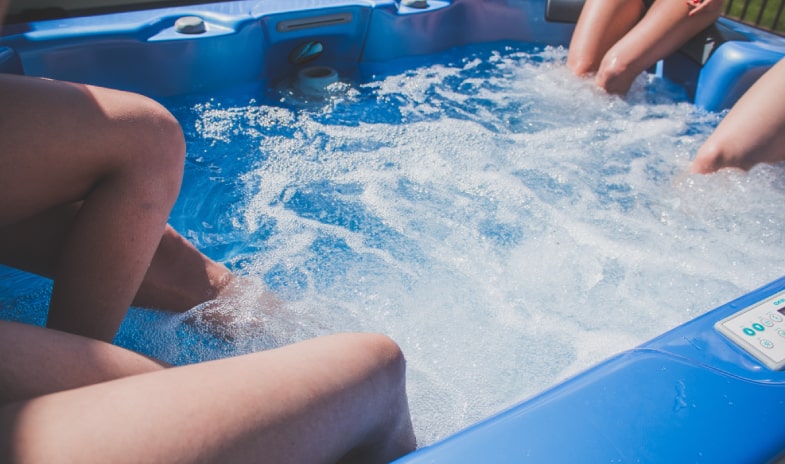
Your backyard hot tub is the perfect place to relax… except when it keeps tripping the GFCI circuit breaker! Your hot tub keeps shutting off – what do you do?!? These breaker trips are more than a nuisance; they could be signalling danger. Water and electricity (especially malfunctioning electricity) are a potentially hazardous combination.
If your hot tub breaker won’t reset, check for the 6 issues listed below. Then hire a professional electrician with hot tub experience to resolve the problem.
Do You Need A GFCI Breaker For A Hot Tub?
First things first: Yes, you do need a GFCI (Ground Fault Circuit Interrupter) breaker for your hot tub. Many electrical issues can occur, including dangerous short circuits and outlets being hot to the touch .
Amateurs attempting to set up their hot tub alone often make the mistake of installing a regular 2-pole breaker (which happens to be cheaper). Errors like this are why we don’t recommend doing complex electrical projects yourself .
According to Rule 86-068 of the Canadian Electrical Code, all spas and hot tubs require GFCI breakers for their electrical system. The job of a GFCI is to protect you from electrocution due to ground fault shock while you are in or around the water.
In addition, you’ll need to upgrade your electrical panel , to meet the high demand for your hot tub.
6 Reasons For Repeated Hot Tub GFCI Trips
1. old gfci breaker.
Ground fault circuit interrupter breakers are pretty sturdy, but they will eventually wear out, usually after 10-25 years. Lightning strikes or frequent power surges can shorten their lifespan.
When you suspect that your GFCI has tripped because it is too old or has been damaged, test it this way:
- Flip the hot tub circuit breaker to ON.
- If it immediately re-trips, disconnect all appliances connected to that breaker.
- Now flip the GFCI breaker back to ON.
- If it does not trip this time, there is a problem with something you usually plug into the breaker, like a heater, pump, or hot tub component.
- If it does trip again, the breaker itself has gone bad and will have to be replaced by a qualified electrician. Ask whether a power surge caused the problem and if so, inquire about surge protector installation.
2. Faulty Heater
Very often, the source of repeated GFCI breaker trips is the hot tub’s heating element. Disconnect the heater from the electrical system and test the breaker as described above. If the breaker trips only when the heater is connected, you’ve pinpointed the culprit.
The next step is to figure out what caused the problem with your heating element in the first place. Running the heater without enough water in the hot tub, clogs, faulty circulation, and chemical deposits are the most common reasons.
To fix the issue, it might be possible to have only the heating element replaced, depending on your heater type. With some models, though, the entire heater will require replacement.
3. Corroded Components
Rust tends to be a problem in any moist environment. It can corrode your electrical components in a hot tub, including the wiring, connectors, ground wires, or control panel.
WARNING: Always turn off the main electrical supply before inspecting anything to do with electricity. Do not stand in hot tub water or touch anything wet.
Open the electrical box, looking for rust or white powder signs, which indicate corrosion is present. Then check all components; a flashlight can help with this task. Minor corrosion may be removed with a brush. More severe corrosion means that you will probably need to have the wiring redone by a professional electrician .
4. Moisture Within Your Breaker Box
Moisture could be seeping into your hot tub breaker box due to splashing, condensation, rain, or flooding. If so, when the GFCI trips, it is doing its job of keeping you safe from the dangerous mixture of moisture and electricity.
To investigate, turn off the main electrical supply; next, inspect the interior of the breaker box. Try drying any visible moisture with an absorbent cloth, then run a fan, blow dryer, or dehumidifier near the breaker box to dry it more thoroughly. Replace the rubber seal.
Once the breaker has been well dried, there ought to be no further trips. If there are, it could be a signal that you should put up a splash barrier, move the breaker box farther away from your hot tub, or replace the box altogether.
5. Unsecure Electrical Wiring
Another possible cause of frequent breaker trips is unsecure electrical wiring. This can take several forms:
- loosened connections
- sagging wires
- cables touching each other
- wires whose rubber insulation has melted or burnt
- wiring chewed by rodents or other pests
Once again, you will need the services of a certified electrician, who will tighten the connections, separate the cables, or replace the damaged wiring.
6. Flooded Air Blower Or Ozonator
Your hot tub air blower is a fun hot tub accessory, while the ozonator is necessary for tub maintenance and hygiene. However, both might occasionally flood from backflow when filling your hot tub too full or one of the valves has failed. The solution is to empty some of the excess water and, if necessary, to have the faulty valve replaced.
Sun Electrical Will Make Your Hot Tub Safe And Fun
We are professional electricians in the Calgary area who have solid experience working with hot tub problem solving. Contact us for reliable hot tub repair and installation . We’ll do it right, to make your hot tub as safe as it is fun!
REQUEST A QUOTE
WCAG 2.2 Commitment: We strictly adhere to WCAG 2.2 AA guidelines.
Personalized UI: Users with disabilities can personalize the interface.
AI-Based Compliance: We use AI to maintain accessibility during updates.
ARIA Attributes: Meaningful data for screen-readers using ARIA attributes.
Optimized Screen Reader and Keyboard Navigation:
Screen-reader Optimization: ARIA attributes for meaningful data.
Image Description: Auto image descriptions for better understanding.
OCR Technology: Text extraction from images.
Keyboard Navigation: Enhanced keyboard operability.
Content-skip Menus: Easy navigation with shortcuts.
Popup Handling: Improved handling of popups.
Shortcuts: Quick access to key elements with shortcuts.
Specialized Profiles for Disabilities:
Epilepsy Safe Profile: Safe browsing with reduced triggers.
Vision Impaired Profile: Enhanced interface for visual impairments.
Cognitive Disability Profile: Assistive features for cognitive disabilities.
ADHD-Friendly Profile: Minimized distractions for ADHD users.
Blind Users Profile: Compatibility with popular screen-readers.
Keyboard Navigation Profile: Navigate with keyboard commands.
Customizable User Interface Adjustments:
Font Adjustments: Customize font settings for readability.
Colour Adjustments: Choose contrast profiles and color schemes.
Animations Disable animations for user safety.
Content Highlighting: Emphasize key elements.
Audio Muting: Instantly mute the website.
Cognitive Disorders: Linked search engine for better understanding.
Additional Functions: Various customizable options.
Browser and Assistive Technology Support:
Supported Browsers: Google Chrome, Mozilla Firefox, Apple Safari, Opera, Microsoft Edge.
Supported Screen Readers: JAWS (Windows/MAC), NVDA (Windows/MAC).
Continual Accessibility Improvement:
Ongoing Efforts: We continuously enhance accessibility.
Goal: Achieve maximum accessibility with evolving technology.
Contact Us: Reach out via the website’s contact form for queries or concerns.
Content Settings
Browsing Settings
- Everything you need for your hot tub, pool or spa - built on the success of buildahottub.com

- Search for:
No products in the cart.
Return to shop
- Circulation Pumps
- Heating Elements
- Keypad Overlays
- All Categories
- About / Contact
Hot Tub Parts Related
7 reasons your hot tub is tripping the breaker.
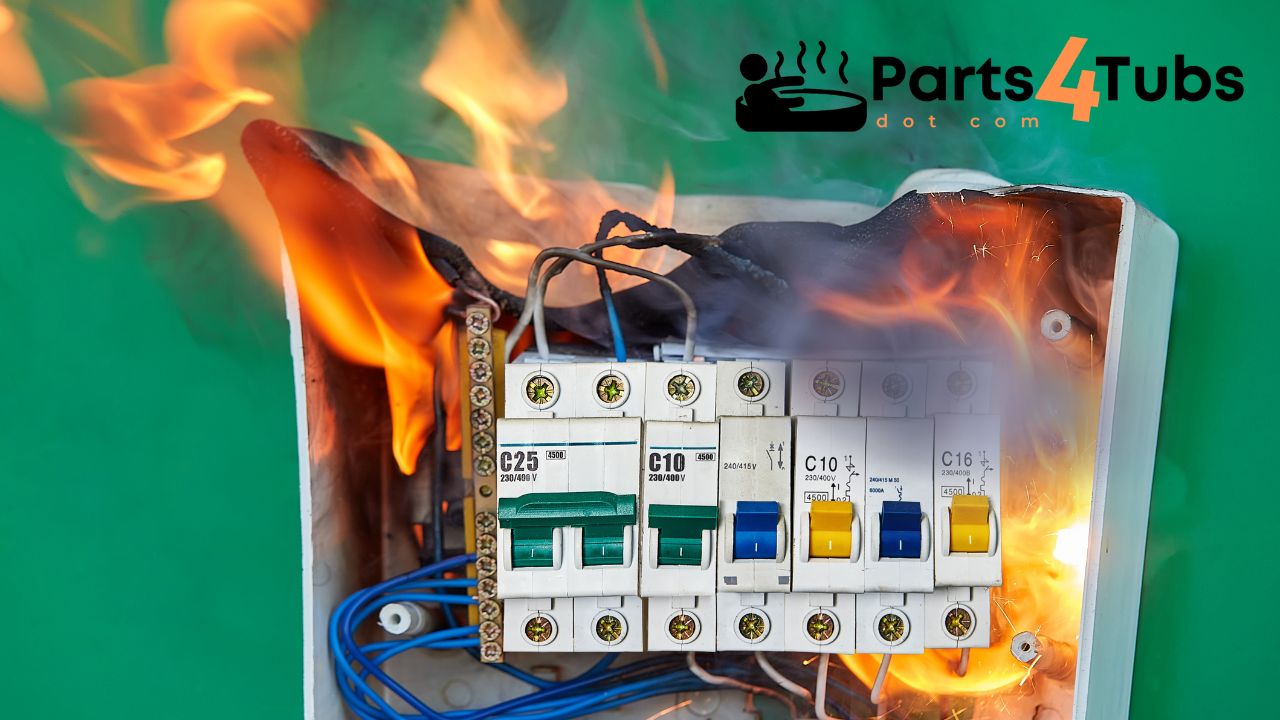
Hot Tub Tripping the Breaker?
Picture this: a serene evening, the stars above, and a warm, inviting soak in your beloved hot tub. But just as you’re about to unwind, your hot tub suddenly goes dark. Frustrating, right? Tripped breakers in hot tubs can be a real buzzkill, leaving you wondering what went wrong. In this article, we’re going to delve into the seven most common reasons why your hot tub might be tripping the breaker. Understanding these culprits and their solutions can help you get back to enjoying your hot tub without any interruptions. So, let’s troubleshoot the issue and get your relaxation sanctuary up and running smoothly once again.
What are 7 reasons your hot tub is tripping the breaker?
Certainly, here are seven common reasons why your hot tub might be tripping the breaker:
- Electrical Overload: One of the most frequent causes is an overloaded electrical circuit. Hot tubs require a dedicated circuit with the appropriate amperage capacity. If your hot tub is drawing more current than the circuit can handle, it will trip the breaker.
- Water Leaks: Water and electricity don’t mix well. If there’s a leak in your hot tub’s plumbing or electrical components, it can lead to short circuits and trip the breaker as a safety precaution.
- Faulty Heating Element: A malfunctioning heating element can cause excessive power usage, leading to breaker trips. If the element has a damaged or compromised sheath, it can come into contact with water, resulting in a short circuit.
- Aged or Damaged Wiring: Over time, the wiring in your hot tub can degrade or suffer damage from various factors, including rodents, weather, or wear and tear. Damaged wiring can lead to short circuits and breaker trips.
- GFCI Issues: Hot tubs are equipped with Ground Fault Circuit Interrupters (GFCIs) to protect against electrical faults. If the GFCI is faulty or improperly wired, it can trip the breaker. Regular GFCI testing and maintenance are essential.
- Circuit Board Problems: The control circuit board in your hot tub manages various functions. If it’s damaged, corroded, or malfunctioning, it can send irregular signals, causing the breaker to trip.
- High Ambient Temperature: Extremely hot weather can lead to overheating of your hot tub’s components, especially if it lacks proper ventilation. When components overheat, they can draw more current and trip the breaker.
Identifying the specific cause of your hot tub’s breaker trips may require a professional inspection, especially if you’re not familiar with electrical systems. It’s essential to address these issues promptly to ensure the safety and functionality of your hot tub.
How can I identify what component is tripping the hot tub breaker?
Identifying which specific component is causing your hot tub breaker to trip can be a systematic process. Here’s a step-by-step guide to help you identify the culprit:
- Turn Off All Components: Start by turning off all the hot tub’s components, including the jets, lights, and the heater. Make sure everything is in the “off” position.
- Reset the Breaker: If the breaker has tripped, reset it to the “on” position.
- Turn On One Component: Begin by turning on one hot tub component at a time. For example, you can start with the jets. Allow each component to run for a few minutes to see if the breaker trips. If it does, you’ve likely identified the problematic component.
- Inspect for Water Leaks: If the breaker tripped when turning on a specific component, inspect that area for water leaks. Look for signs of water pooling or wet electrical connections. Water and electricity are a dangerous combination.
water leaks are indeed one of the most common causes of hot tub breaker tripping. Here’s some additional information about how water leaks can lead to this issue:
Water Leaks and Breaker Tripping:
- Exposed Wires: Water leaks in a hot tub can result in exposed electrical wires. When water comes into contact with these wires, it can create a short circuit, causing an overload in the electrical system. This overload can trip the breaker as a safety measure to prevent damage and electrical hazards.
- Corroded Connections: Prolonged exposure to moisture from leaks can lead to corrosion on electrical connections, especially on the control circuit board. Corroded connections can disrupt the proper flow of electricity, leading to irregularities and potentially tripping the breaker.
- Ground Faults: Water leaks can also create ground faults when water provides an unintended path for electricity to flow to the ground. Ground faults can trip Ground Fault Circuit Interrupters (GFCIs) or cause the main breaker to trip if a GFCI is not present.
- Heater Element Damage: Leaks near the heating element can damage its sheath or cause electrical connections to become wet. This can lead to a short circuit when the heater is activated, causing the breaker to trip.
Identifying Water Leaks:
To identify and address water leaks that may be causing your hot tub breaker to trip:
- Inspect the Hot Tub Cabinet: Look for signs of water pooling or moisture inside the hot tub cabinet. Pay close attention to areas around components, plumbing connections, and the control panel.
- Check for Dripping: Observe the hot tub while it’s running. If you notice water dripping from any component or connection, it’s a clear indicator of a leak.
- Inspect Seals and Gaskets: Examine the seals and gaskets around jet nozzles, pumps, and other penetrations in the hot tub shell. Damaged or deteriorated seals can allow water to seep into electrical compartments.
- Address Leaks Promptly: If you identify a water leak, it’s crucial to address it promptly. Turn off the hot tub’s power supply, drain the water to a safe level, and repair or replace any damaged components, seals, or connections.
By regularly inspecting your hot tub for water leaks and addressing them promptly, you can help prevent breaker trips, electrical damage, and ensure the safety and functionality of your hot tub.
- Check the Wiring: Examine the wiring and connections associated with the component that caused the breaker to trip. Look for exposed wires, damaged insulation, or loose connections. Pay close attention to the area around the component you suspect is causing the issue.
- Test the GFCI: Ground Fault Circuit Interrupters (GFCIs) are designed to protect against electrical faults. Check if the GFCI associated with the problematic component has tripped. Reset it and see if the problem persists.
- Heating Element Inspection: If the breaker trips when the heater is turned on, inspect the heating element. Ensure the heating element’s sheath is not damaged, which could cause a short circuit.
- Inspect the Control Circuit Board: If you’ve ruled out other causes, a malfunctioning control circuit board could be the issue. Look for signs of corrosion, damaged components, or loose connections on the board.
- Professional Inspection: If you’re unable to identify the issue or if it involves complex electrical components, consider hiring a qualified hot tub technician or electrician. They have the expertise and tools to diagnose and repair electrical problems safely.
- Regular Maintenance: To prevent future breaker trips, schedule regular maintenance for your hot tub. This includes inspecting and cleaning components, ensuring all connections are secure, and addressing any issues promptly.
Remember, safety should be your top priority when dealing with electrical components. If you’re unsure about any aspect of troubleshooting or repair, it’s best to seek professional assistance to avoid risks associated with electricity and water.
In Conclusion
In conclusion, a tripping breaker in your hot tub can be a frustrating issue, but it’s a vital safety feature designed to protect you and your spa from electrical hazards. By understanding the common reasons for breaker trips, such as water leaks, electrical overloads, or component malfunctions, you can take appropriate steps to diagnose and address the problem.
Regular maintenance, including inspecting your hot tub for leaks, keeping electrical connections dry and well-maintained, and ensuring that all components are in good working order, is key to preventing breaker trips. If you’re unsure about the cause of the tripping or how to resolve it, don’t hesitate to seek professional assistance from a qualified electrician or hot tub technician.
Remember that safety should always come first when dealing with electrical issues in your hot tub. By maintaining your hot tub and staying vigilant for potential problems, you can enjoy a safe and relaxing spa experience year-round.
Happy Hot Tubbin’
Can I Help You?
If I can help you in any way I would love to hear from you. You can get in touch using the form below.
Thanks - Andi
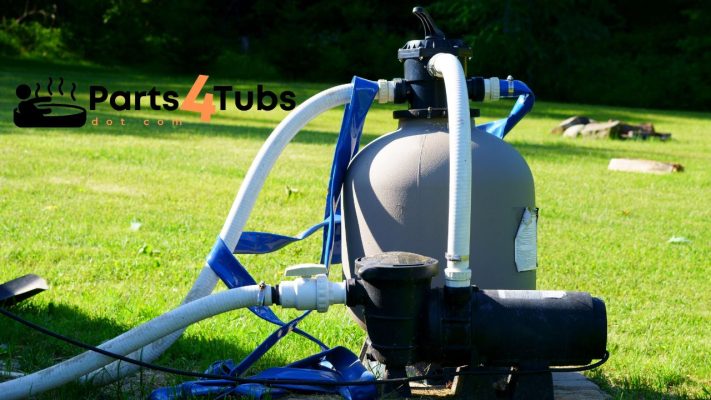
The Great Pool Filter Showdown: Sand vs. Cartridge – Unveiling the Hidden Depths
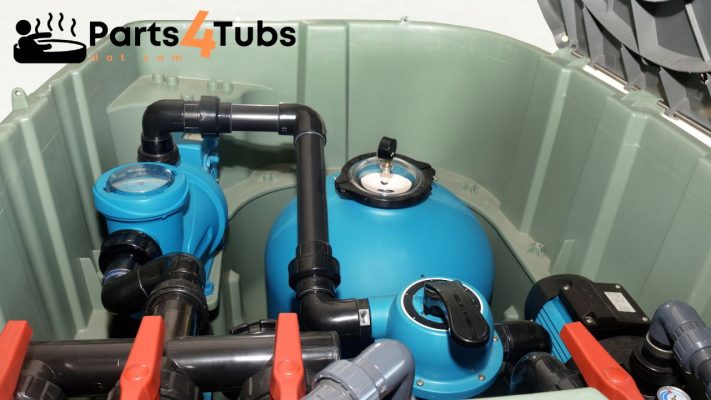
Poolside Panic: Don’t Get Swept Away by the Wrong Sand Filter!
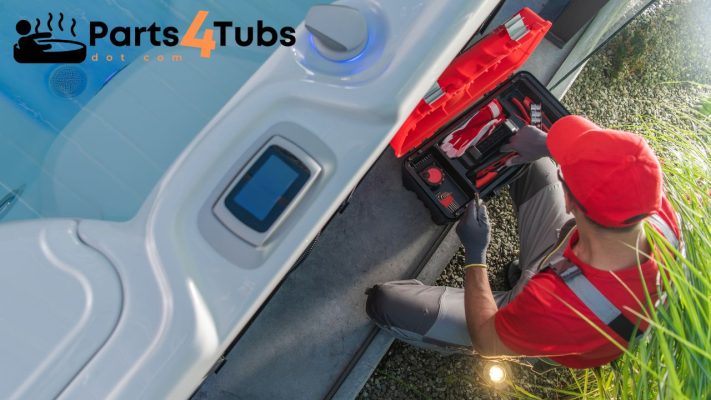
Should I Repair or Replace My Hot Tub Pump?
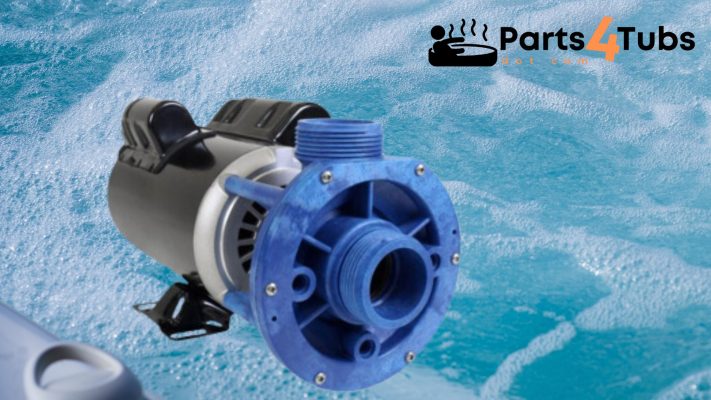
Watkins Wavemaster 7000 – Are you looking for a replacement pump?
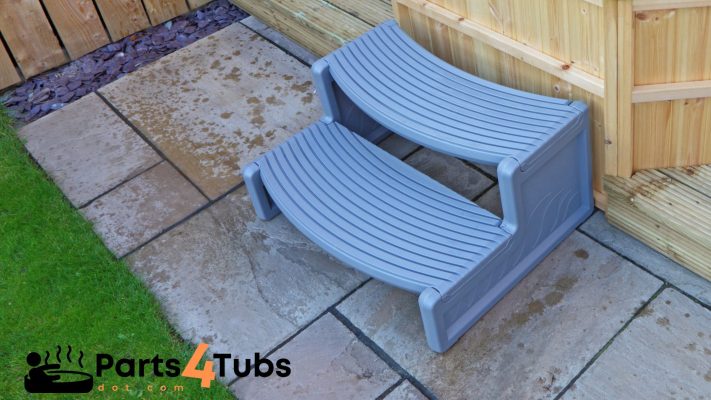
Hot Tub Steps – The Ultimate Guide
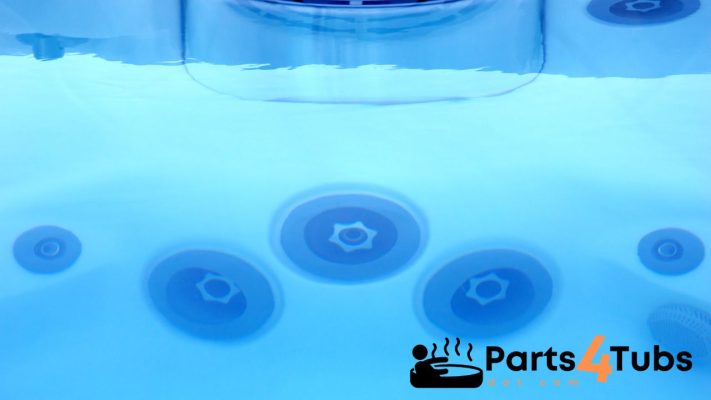
How to Identify a Replacement Hot Tub Jet
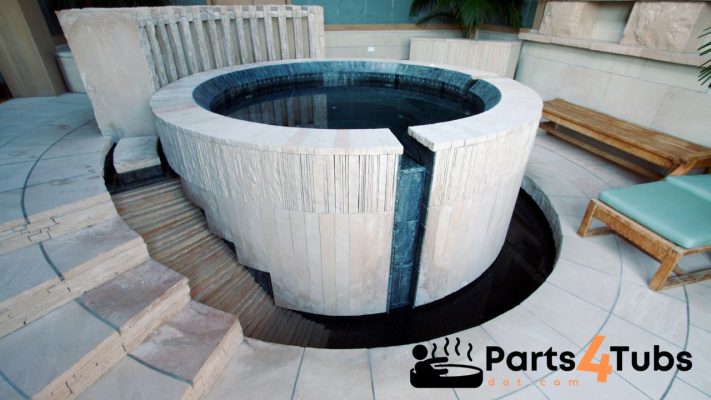
How To Prevent and Remove Hot Tub Scum
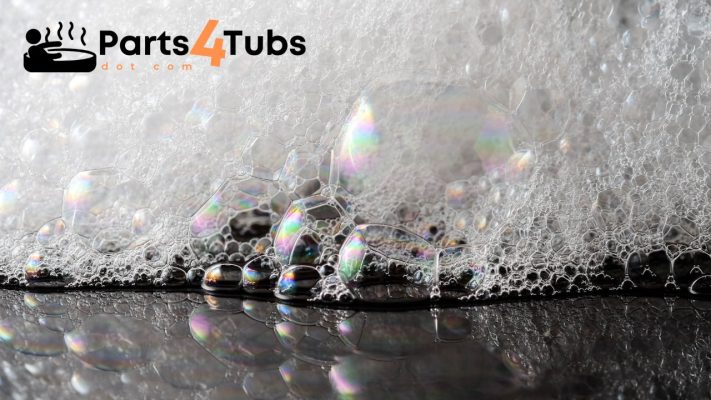
How to Get Rid of Foam in a Hot Tub
Username or email address *
Password *
Remember me Log in
Lost your password?

Why Does a Hot Tub Breaker Keep Tripping? Possible Reasons and How to Solve
Do you have a hot tub whose circuit breaker trips regularly, stopping you from having its hydromassage benefit? Do not panic: the main causes of this inconvenience are easy to spot. In most cases, the problems are a short circuit, a ground fault, a worn-out circuit breaker, moisture, corrosion, and a few other reasons.
Here are our tips for diagnosing the origin of the problem of a hot tub breaker that keeps tripping, and how to react accordingly. But first, why do you need a circuit breaker in your hot tub?
- Why Does Your Hot Tub Need a GFCI Breaker?
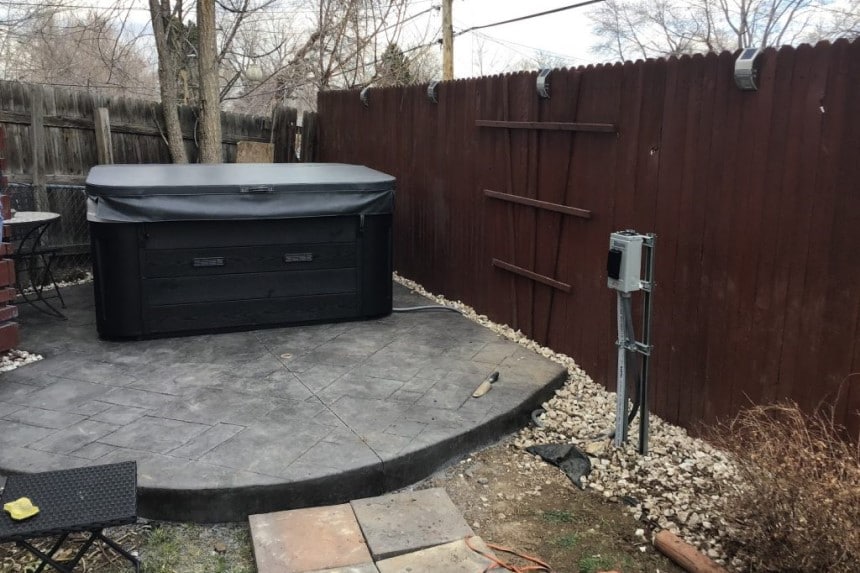
The hot tub electrical equipment consumes a lot of energy and therefore it needs a separate circuit breaker to operate efficiently.
Water and electricity are a deadly combination. Therefore, to enjoy your hot tub safely without fear of electrical hazards, you should install a circuit breaker. Receptacles of pool and spa installations are subject to the NEC code Trusted Source StackPath www.ecmweb.com which states that these units must be GFCI-protected and locked.
All electrical work performed around or near your pool or spa should be plugged into a GFCI, that is, a GFCI breaker. This is intended to protect yourself and your loved ones from electric shock and is especially important in areas around water. Unlike the regular fuses that you can find inside a home, a GFCI is built into an appliance. It works by monitoring and controlling the electrical energy that goes into a device.
If the power source is accidentally dropped into the water, the GFCI will be able to detect it and shut off the power. This is essential when working with electronic devices near the hot tub and can even save your life. If you are working with a professional, they should know the ins and outs of these procedures, but it is good if you know them too!
Many people end up using the overcurrent protection device as a switch for their hot tub, which can be dangerous. This is because the constant on / off switch can cause damage to the bus bar. Even a small space on the bus bar can cause an electric arc, which is one of the main reasons behind electrical fires. Therefore, it would be a good idea to install a separate emergency switch for your hot tub along with an individual GFCI overcurrent protection device.
- How Does a Circuit Breaker Work?
A circuit breaker Trusted Source ▷ How does a Circuit Breaker work? engineering.electrical-equipment.org is a device necessary for any type of building, whether for a home, appliance, or room. Its role is essential for the safety of the equipment or even the entire premises: it prevents fires, short circuits and controls the electrical voltage, to avoid overloading the devices.
A circuit breaker is in a way the guardian of the electrical circuit, which manages the unit in terms of power. A GFCI breaker is integrated into the hot tub, so you do not need to install a circuit breaker dedicated to the spa in your electrical panel.
The Most Common Reasons of a Tripping Circuit Breaker
Below, we dive into the most common reasons why your circuit breaker may keep tripping and how to deal with them.
- Reason #1: Worn-out Circuit Breaker
One of the reasons your hot tub keeps tripping the circuit is because the thing just wore out. Power surges, age, or a lightning strike can make your breaker unusable.
Fortunately, it’s quite easy to know if your breaker is broken.
Try to flip it. Does it trigger again immediately? If so, then a worn-out or a bad breaker might be the problem.
Disconnect everything on the GFCI switch. Turn it back on. Now, if it keeps tripping, then you need to have the breaker replaced. One of the most recommended for a hot tub is the Eaton GFTCB250 . It’s a plug-on mount type Ground Fault Circuit Breaker (GFTCB). It has an amperage rating of 50 amperes.
If you have to change the whole GFCI, the Siemens QF260A 60 Amp can be purchased. It’s a ground fault circuit interrupter with a self-test feature.
- Reason #2: Moisture
Moisture could also be a reason your circuit breaker is tripping. If it’s an outdoor hot tub, then you could have moisture problems which can be causing it to trip. A hot tub cover can be helpful when the unit is not in use. Leakages from some plug and play hot tubs can also cause moisture problems
Open the GFCI breaker box, then shine your flashlight inside. See whether there is moisture in it. Rainwater can bring in enough moisture to trip a spa circuit breaker.
The solution can be as simple as towel drying the inside of the breaker box and turning on a fan near the electrical outlet.
Then, you’d need to reset the breaker once it’s dry.
If the circuit breaker still trips when it looks dry, then it may need additional troubleshooting. If there is frequent exposure to moisture, replacing the outlet or moving it further away from the hot tub may be needed.
- Reason #3: Corrosion
Corrosion is unavoidable. Even in space, there is no escape from rust. It pays to watch out for corrosion every time your hot tub is serviced to reduce the chance of the problems getting worse.
Corrosion may cause the breaker’s components to stop working, affecting water chemistry or causing further damage if they fail. Imagine you are going on vacation then your system is not running as programmed. Yuck.
Corrosion problems can be found near the spa GFCI or on the tub’s components. Check the GFCI breaker box, and then the inside of your hot tub, for corrosion signs. If there is corrosion, you will usually see a whitish powder or rust around the connections of the components. Carefully examine the cable connections, the control panel, ground wires, and any places where you can see the wiring to the components.
Repairing corrosion will depend on where you found it as well as how bad it is.
It’s possible to clean the corroded connectors with a contact cleaner or a metal brush and just plug them back in. A typically good example of a contact cleaner is the CRC 3140 Contact Cleaner . It’s also a protectant that is available in an aerosol can.
If this corrosion has progressed too far, you may have to replace the wiring. If dripping water is causing the corrosion, you need to fix a leak in your hot tub.
- Reason #4: Defective Accessories
All hot tubs have several electrical components like the heater. An inflatable spa even has a heater and control panel.
If you particularly have a modern hot tub, it may also feature a towel warmer, interior lighting, or a sound system. If one of the electrical components is not working well, that could be the reason the hot tub is blowing your fuse.
The easiest way to isolate a faulty spa component is to disconnect whatever is possible from the breaker. Then connect every component individually. Turn the breaker off. If it trips, you know the problem.
However, identifying the culprit component is just half the problem solved. You also need to find out the reason the component malfunctioned. Could the wire connection be bad? Has the component overheated? Is it improperly grounded? Has the device been destroyed? It’s always best to leave these to the professional’s expertise.
- How to Generally Repair Your Breaker That Jumps
Even when it jumps, make sure your breaker is properly closed. Avoid unfortunate surprises and take the time to put it back and see it trigger.
- Open the mechanical access to your spa and inspect visually to locate clues that will guide you in your diagnosis, such as water on an electrical component, a burnt trace, a melted wire. If the inspection does not find a sign of a problem, continue the diagnosis to identify the source of the electrical failure.
- Open the control box of your hot tub, and check that you have no voltage on the terminal block. Then, unplug each accessory from your hot tub and try to put the breaker back on each time.
- Starting with the blower is the second biggest source of problems. If the breaker still does not hold, try it with the circulating pump, follow with the primary pump, the secondary pump, the Ozonator, and so on until the breaker holds.
- The last unplugged accessory is the source of your problem and needs to be repaired or replaced. No need to disconnect the small accessories on the direct current (12v light, led, etc.) If it still does not hold, rather go to the next step, the water heater.
- To disconnect the water heater, you will generally need to remove flexible connectors or flat copper connectors that connect it to the electronic board. In some spa models, a wire connects the water heater in the box. Look for the red-colored connector.
- Once the water heater is disconnected, your spa should no longer have any accessories connected to the control box except the top side. The breaker should therefore hold. This means, by inference, that your water heater is the problem.
- You must therefore replace the internal element. Which is simple, in most spas. Some spa manufacturers use water heaters whose elements cannot be replaced. You will need to replace the whole part in this case.
- If you have unplugged everything, and the breaker jumps, well, you have confirmed that your spa is not the problem. Then you must look elsewhere. If your spa is newly connected, your connection may be the cause.
Caution! Intervening yourself on your electrical installation can be dangerous. It is strongly recommended not to handle electrical devices that may be faulty or electrical wires without first having switched off the main circuit breaker. When in doubt, always call a professional.
- Final Thoughts
One of the most common problems experienced by hot tub owners is when the hot tub breaker keeps tripping. Electricians suggest that you make sure to use a properly sized circuit breaker to run your device. If the problem persists even after replacing your old circuit breaker and using a new GFCI especially for your equipment, then you should extract your user manual and do some checks. Make sure your hot tub filter is clean and not damaged. The circuit breaker may also trip if there is a problem with your hot tub’s Ozonator or air blower. Keep these tips in mind and you should enjoy the safe use of your hot tub.
Your email address will not be published. Required fields are marked *
Save my name, email, and website in this browser for the next time I comment.
Post Comment
- 1 hot tub high limit switch location
- 2 hot tub troubleshooting
- 3 diy hot tub
- 4 how to remove bathtub drain
- 5 how to unclog a bathtub drain
- hot tub cover Most popular | Sep., 2023
- 2 tub surrounds
- 3 freestanding tubs
- 4 drop in bathtub
- 5 soaking tub
- the one stop shop for the diy'er building hot tubs and plunge pools
- How I can Help
- How to Build a Hot Tub
- Case Studies
- Hot Tub Course
- DIY Hot Tub Building
- Air Source Heat Pump Related
- Support & Maintenance
- Design / Ideas Related
- Materials and Construction Related
- Plumbing Related
- Reviews & Info
- Cocktail & Plunge Pool Related
- Stock Tank Hot Tub
9 Reasons Your Hot Tub Is Tripping the Breaker
Why is my Hot Tub tripping the breaker? A Hot Tub in your home can be a great way to relax. However, if your Hot Tub’s circuit breaker continues to trip, it’s not so relaxing and frustration creeps in. Come on, tell it as it is. You probably want to pull your hair out. I know I did when mine continually did this. (And I dont have a lot of hair left to be pulling out!)
What are the possible explanations? A daily visit to the circuit breaker may indicate a serious problem. Don’t worry, a Hot Tub that triggers the breaker is not an unusual phenomenon and it is fairly easy to identify potential causes. All you need to know is what you are looking for and where to look.
Once you have found the problem, you will be surprised how easy it is to solve. Some repairs may require some skill, but that depends on your electrical expertise.
Here are some are the most common reasons why your Hot Tub is tripping the breaker.
Worn Hot Tub GFCI Breaker
Perhaps the most likely explanation for your Hot Tub’s power switch tripping is that it has simply worn out. Age, power surges and even a lightning strike nearby can render the switch unusable. Fortunately, you can tell immediately if the breaker is broken. Try turning it off you already haven’t done so. Will it turn on again immediately? If not, your problem may be a rusty or defective switch. To be sure, switch it on and off again. With an electric meter, you can test if the power is coming into the circuit breaker. Careful though, you are talking 110/240V – it is not like a battery if you get it wrong. If the switch is not transferring the current when it is in the on position, it is clearly broken and needs replacing
Ground fault:
A ground fault occurs when electricity flows through the water and into the ground, rather than through the wiring. This can happen if there is a fault in the hot tub’s wiring or if the hot tub is not properly grounded.
Moisture Exposure
If there is moisture in the Hot Tub circuit breaker’s control box, this will cause the switch to trip frequently. Moisture and water cannot be present across a circuit. Moisture on the live or bridging the live and the neutral connections will cause the circuit to trip. Condensation, water or moisture from rain can penetrate into these boxes oner time. When this happens, moisture inside the control box will eventually damage the electrical components. They can rust, they can then arc and cause the circuit to trip. To protect the Hot Tub control box from excessive moisture, make sure that the rubber seal is in tact and that the holes used for the cable in and out of the box are well sealed.
If there is moisture in the box. Dry it out, replace the seal and try again. If it still is tripping, the problem is either not in the box itself and is elsewhere on the circuit, or the breaker needs to be replaced.
The amount of times that I have had my wife’s hair dryer on various Hot Tub electric parts over the last couple of years is untrue! Electricity and water do not mix – even in a Hot Tub!
Heater Corrosion or Damage
Hot Tub heaters can be corroded over time, which can result in a tripping of the circuit breaker. If this essential part of your hot tub shows signs of damage or corrosion it is time to replace the heating element. They are relatively inexpensive but it is just not worth messing around with corroded old parts trying to make them work.
Quick test, you can actually unplug the heating element from the Spa Pack control box. Do this, flip the breaker to give it power and if the breaker remains on, then you know that the heating element is the part at fault. Replace it, job done.
Just as a side note, white powder or rust is usually visible around components when corrosion is present. Cable connections, ground wires, panels, and areas where cables are visible should be carefully inspected for any kind of deposits. They shouldn’t be there, it should be totally clean inside the control box.
These elements are pretty easy to change out so it shouldn’t be too much of a problem is this is the cause of the breaker tripping.
Short Circuits
Short circuits can occur in any of the electrical parts of your Hot Tub where electricity is connected. Breakers are designed to trip in the event of a short circuit to protect both the user of the Hot Tub but also the components in the Spa Pack.
A short circuit can occur if any electrical area is wet. Check seals on things like the Spa Pack – there should be no water or moisture in there. The blower, should be totally dry. In fact, the only things that should have water anywhere near or in it is the Tub itself. Your control room should be dry, period!
Case back any wires from source to where they are connected. Check for loose connections, Check for any water ingress signs into the electrical parts. Secure any loose wires. Change any seals if water has got into any of the components. Unplug all of the components heater, blower etc and then try them one by one to see what is the root cause of the tripping of the breaker. Faulty component, repair or better still change it. Its just not worth the hassle.
Loose Electrical Connections
Over time the electrical connections can become loose in your Hot Tub. This can lead to power fluctuations that cause your circuit breaker in the Hot Tub to trip. Experienced electricians will inspect your Hot Tub and secure any loose connections that could solve the breaker problem.
Loose connectors are fairly easy to repair. You may need to use a screwdriver to secure the screws within your Hot Tub Spa Pack to keep the wires in place. Alternatively, plastic plug-in connectors can be seen sliding out of place. Give just a quick, little push to the plastic plugs to make sure they are secure. And of course if there are any connectors missing or broken, you’ll have to patch them.
“Naughty Components”
All Hot Tubs have electrical components – we’ve spoken already about the core components of your Hit Tub – blower, heater etc. Now let’s turn our attention to the accessories. You may also have a towel warmer, a sound system or interior lighting in the Hot Tub. If any of the electrical components are not working properly, it may be because the Hot Tub tripping the breaker.
The best way to fault find is to unplug all these additional components and then replug them one by one trying the breaker as you go. If you can find the offending part, it might be easier to replace than try to repair – really depends on exactly what has failed.
Do this systematically though, if it trips leave it in and move to the next one. The last thing you want to do is unplug everything for it to be ok and you still be none the wiser to what is causing the problem! Take your time and identify the “naughty component”
Bad Heating Element
The heater really is key to a, you guessed it “Hot” tub. It is also the part that gets used the most. It takes a battering being submersed in water that should not be too acidic but high in chlorine which is a corrosive beach. If the coil begins to rust and break down then this could be causing the breaker to trip.
Most heaters can be removed and replaced separately from the Spa Pack. Unplug the heater from the control board and then try the circuit breaker – this will help identify if the element is the part causing the trip.
You can also use a multimeter to measure the resistance of the coil between the two connections. Very low or very high readings indicate that something is not quite right and should probably be replaced.
Flooded Air Blower
Water and electrics certainly do not mix. If you have water in your blower, then the chances are that your hot tub is going to trip the breaker. You can end up with water in your blower if your check valves have failed and you don’t have Hartford loops in your air lines. These prevent the water draining from the jets into the air lines. Eventually, water will try and settle at the lowers place which is usually the blower if it is located at the bottom of your Hot Tub cabinet.
Whilst you can dry out your blower, once you get water in them, they tend to rust. Once the rust builds up, you will find that they trip once again, even when there is no water in the blower.
In this scenario, it is best to replace the blower with a new one. It is a relatively inexpensive and easy job to do.
Breakdown in the Coil on the Pump
A breakdown in the coil on the pump can cause the hot tub to trip the breaker. Here’s why:
The pump in a hot tub is responsible for circulating water through the jets and the filtration system. The pump contains a motor that is powered by electricity, and the motor has a coil of wire inside it that generates a magnetic field to turn the motor shaft.
If there is a breakdown in the coil on the pump, it can cause a short circuit, which can trip the breaker. A short circuit occurs when an electrical current flows along an unintended path, such as through a damaged wire or a faulty component. This can cause an excessive amount of current to flow through the circuit, which can overload the breaker and cause it to trip.
Additionally, a breakdown in the coil on the pump can cause the motor to draw more current than usual, which can also overload the breaker and cause it to trip. This can happen if the coil is damaged or if there is a problem with the bearings or other components in the pump that are causing the motor to work harder than it should.
If you suspect that there is a problem with the pump in your hot tub, you should have it inspected by a qualified technician. They can diagnose the problem and recommend the necessary repairs or replacement to ensure that your hot tub is safe and functioning properly.
Flooded Ozonator
Does the water flow into the ozonator or blower? Are there signs of water in these components at all? If water is present, the circuit breaker will trip. Both of these parts have non-return valves on (or should) which under normal circumstances do not allow water to enter into the components. Quick check, disconnect them and see what causes the trip. Then, inspect them to see if they can be dried out. I submerged my blower once by mistake, not a good idea!
This problem may occur if the control valve or non-return valve is defective so water can flow back into the component. If you are not sure, replace the valve. It’s quick and cheap to do.
Final Thoughts
Whatever the cause of your breaker issue, if all else fails, it is best to leave it to the professionals. When dealing with electrical problems, there is a risk of serious injury or damage to your Hot Tub and components so please please please be careful!.
Can I Help You?
If I can help you in any way I would love to hear from you. You can get in touch using the form below.
Thanks - Andi
Today, I've helped over 1000 DIY customers just like you all over the world build hot tubs and pools. Have a good look around the site, there are lots of resources here. Please do get in touch if I can help you. - Cheers, Andi
Installing a Main Drain for Your Hot Tub or Plunge Pool
Installing the main drains that you are going to need on your hot tub or [...]
Rebar for Hot Tubs and Pool Construction Explained
Imagine soaking in a steaming hot tub or cooling off in a refreshing pool on [...]
Infinity Hot Tub with Swim Jet Takes Shape in Virginia
Have you ever dreamt of soaking in a luxurious hot tub while enjoying a mesmerizing [...]
Keeping Your Pool Crystal Clear: A Deep Dive into Sand Filters
Sparkling pool water is every pool owner's dream. But achieving this oasis of refreshment requires [...]
Demystifying Spa Pack Wiring Diagrams: A Comprehensive Guide with Video Insights
Have you ever stared at a spa pack wiring diagram, feeling utterly lost? You're not [...]
Can I Heat a Hot Tub with Solar Power?
Imagine stepping into a steaming hot tub on a chilly evening, surrounded by nature, and [...]
DIY Pool and Hot Tub – Cameroon, Africa
I love the fact that I can help people literally all over the world with [...]
Which Balboa Topside Control Do I need?
Replacing a topside control, or the buttons that control your jets and adjust your temperature [...]

Here’s Why Your Hot Tub Is Tripping Your Breaker
If your hot tub is constantly tripping the breaker, or it tripped and won’t turn back on, there are a number of possible causes. Most of them are fixable, but some might cost you. Nonetheless, if you want to continue using your hot tub, you’ll have to address the issue one way or another.
Your hot tub might be tripping the breaker due to a worn out GFCI breaker, moisture in the breaker box, a build up of corrosion, damaged wiring, component issues, or a flooded air blower or ozonator. Electrical issues with a hot tub should be addressed as soon as possible to avoid damage or injury.
Luckily, many of these issues can be addressed without professional assistance. Let’s take a closer look at the possible causes behind the problem, how you can fix it, and when to seek out help.
Why Does Your Hot Tub Keep Blowing the Circuit Breaker?
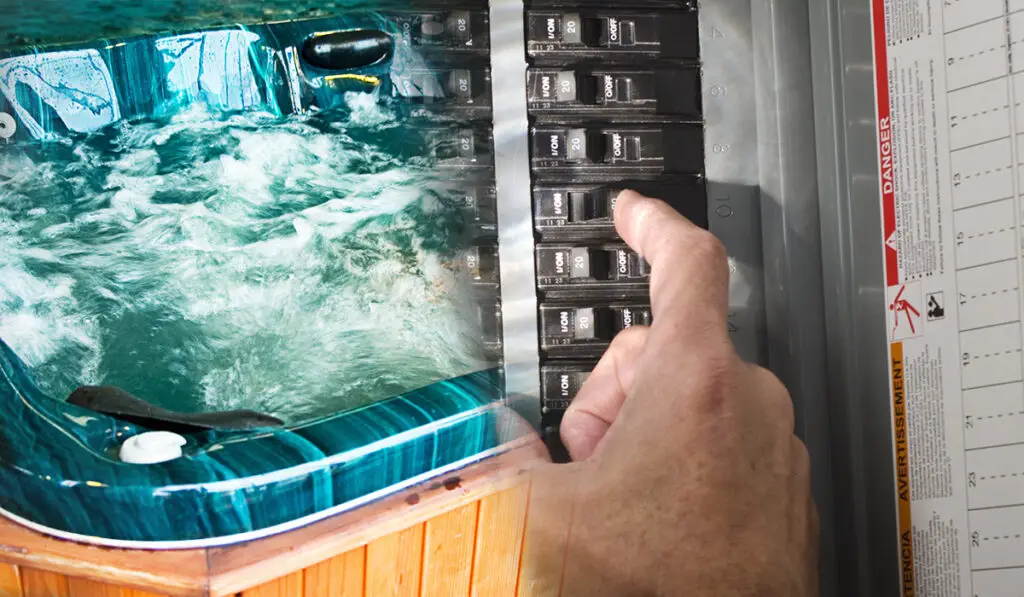
There are many reasons why your hot tub might be tripping your circuit breaker. Some are easier to fix than others, but whenever there’s an electrical issue, it should be dealt with as soon as possible to avoid personal injury or further damage to your property.
Worn Out Hot Tub GFCI Breaker
A worn out GFCI breaker is one of the most common and clear reasons why your hot tub might be tripping the breaker. The simple fact of the matter is that breakers do wear out — and this is something a lot of people overlook.
Age, power surges, or even lightning strikes can render your breaker useless. Thankfully, identifying this fault is fairly easy, and diagnosing the issue is even easier.
The first thing to try is to flip it back. If it immediately trips again, then the breaker is either worn out or faulty. To make sure that this is indeed the cause of your tripping breaker, disconnect everything from the GFCI and flip it back on.
If the breaker still flips with nothing connected to it, then it’s most certainly a worn out breaker and will need to be replaced.

Moisture in the Hot Tub Breaker Box
To determine whether moisture has caused your hot tub to trip the breaker, open up the breaker box and shine a flashlight inside. If you see any moisture build up from rain or flooding then you likely have moisture damage. Even a bit of dampness can make the hot tub flip a breaker.
If this is the case, the first thing you can try is to dry out the box completely with a towel, a fan, or a dehumidifier (on Amazon) near the outlet. Once it’s completely dry, reset the breaker.
If the breaker is still flipping after it’s dried then you’ll need to perform more troubleshooting. You may need to replace the box itself and move it further from the hot tub to avoid this issue again.
Corrosion is a common problem that’s extremely hard to avoid. Rust on the outer side of the breaker is a good example of this, so keep an eye out if you notice any beginning signs of corrosion developing around your breaker box.
Unfortunately, corrosion can cause any component to malfunction, and it can even affect the chemistry of your water quality, which can further damage your hot tub. Corrosion can occur near the hot tub GFCI or around the hot tub itself, so make sure you’re regularly checking the breaker box as well as inside your hot tub cabinet for any signs of damage.
Typically, a white powder or rust will develop around component connections, but be sure to also check wires, ground wires, the control panel, and anywhere else that might have component wiring.
Repairing this kind of damage depends on where it’s been found and how bad the situation is. You might be able to get away with just cleaning it off with a wire brush (on Amazon) or an electrical contact cleaner (on Amazon) and reconnecting the components.
In other cases, you might need to replace any parts that suffered damage.
Loose or Damaged Wiring
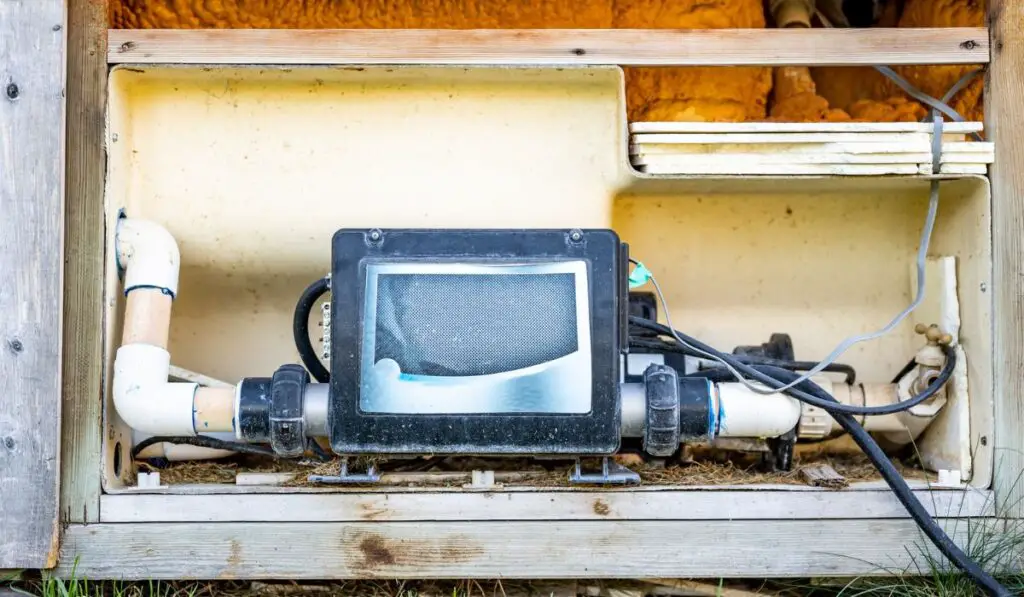
Another thing to look for is damage to the wiring, such as breaks or char marks.
Wiring Short
One issue with wiring is called a wiring short, which occurs when two wires are touching but aren’t supposed to be. This surge of power causes your breaker to trip. It can also happen when a hot wire (one with power going into it) touches a ground wire.
This kind of wiring shortage is extremely dangerous because it not only trips your breaker but can also cause a fire.
To fix this problem, either call an electrician or, using the proper safety protocols, reconnect your wiring properly and make sure the two wires that aren’t supposed to be touching no longer touch.
Burnt Wires
Another wiring issue is known as burnt wires. A short can cause a fire, old wiring can overheat, and hot components can destroy the wires. To find out if this is your issue, shine a flashlight into the breaker box and hot tub cabinet and look for wires with melted insulation. Insulation is the rubber coating around the wires.
Burnt wires can be tricky to fix, so it’s usually best to call a professional to take a look. That way, you can avoid unnecessary damage or injury.
Loose Connectors
Another common issue with wiring is when something comes loose. If your hot tub has been moved around or adjusted in some other way, this can happen.
Even if the wiring is only a little loose, it can cause your breaker to trip. If the component keeps turning on and off, then it’s likely that something is a bit loose.
To fix this issue, use a screwdriver to tighten the screws keeping the wires in place. You can also check to see if there are any plastic plug-style connectors that have slipped out of place and then simply push them back in until they’re firmly in place once more.
Electrical Component Issues in the Hot Tub
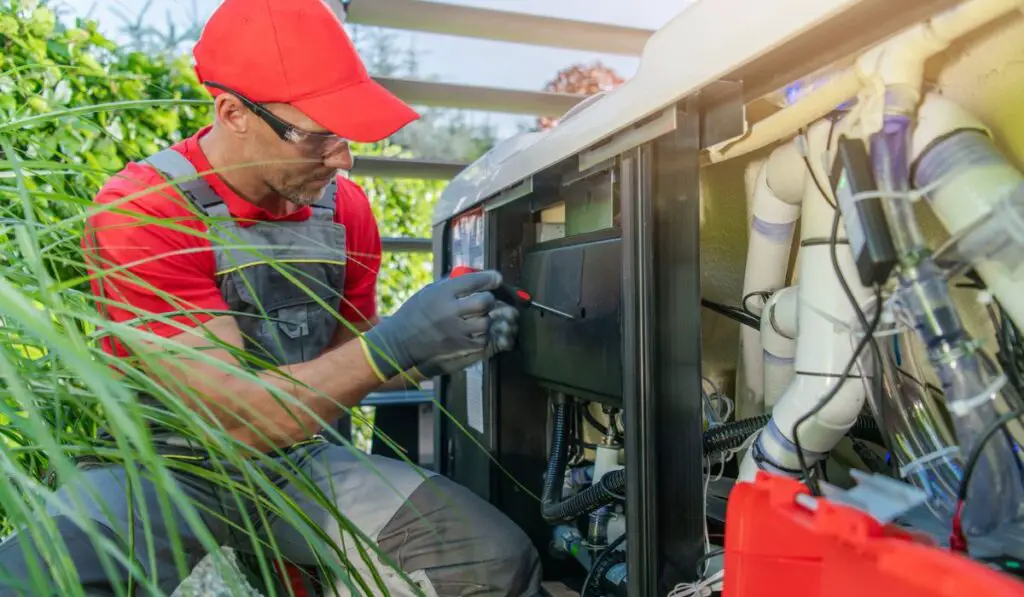
Even if your hot tub is a relatively basic model, they all come with at least a couple electrical components. One of the most common components is the heater; even an inflatable hot tub comes with a heater and control panel. Another culprit could be towel warmers, a sound system, or any interior lighting.
Even if only one of these components is having issues, it can trip your entire breaker.
The easiest way to figure out which component is causing the problem is to disconnect everything from the GFCI and then connect each piece individually to see if it flips the breaker. This method of trial and error can be time consuming, but it’s fairly easy to do yourself.
Once you’ve figured out which component is giving you the issue, you’ll need to determine why it has suddenly started acting up. Unfortunately, this is where it often becomes necessary to contact an electrician for more complex electrical troubleshooting.
Flooded Air Blower or Ozonator
If water is flowing back into your air blower or ozonator, it’ll most definitely cause your breaker to trip. To figure out if this is the issue, disconnect your blower and/or your ozonator from the breaker and try flipping it back. If it continues to trip, then you’ve found your problem.
This issue usually only happens if your check valve is bad or your hot tub has been overfilled, so it’s important to not go over those maximum lines. Drain some of that water, and then, if you need to, replace the bad check valve.
If the blower has gotten wet, then it will also need to be replaced.
How to Test and Reset a Hot Tub GFCI Breaker
Resetting your GFCI breaker is fairly simple to do. Usually, it has a visible reset button on the breaker. The buttons are red and clearly labeled ‘Reset.’
To reset the GFCI you can simply press this button to restore the electricity to your hot tub.
Leave a Comment Cancel reply
Save my name, email, and website in this browser for the next time I comment.
JavaScript seems to be disabled in your browser. For the best experience on our site, be sure to turn on Javascript in your browser.
- My Cart 1 -->
Create an account and enjoy these benefits:
- Easy order tracking
- Faster checkout
- Saved order history
- Earn 100 MSP Reward Points just for sign up!
- Earn MSP Reward Points on every purchase
- Create an Account

- Ultralift Cover Lifters
- CoverMate I Parts
- CoverMate I Eco Parts
- CoverMate II Parts
- CoverMate III Parts
- CoverMate III Eco Parts
- CoverMate Freestyle Parts
- CoverMate Easy Parts
- Cover Valet
- Hot Tub Covers
- Clarity Spa Covers
- Down East Spa Covers
- Getaway Spa Covers
- Healthy Living Hot Tub Covers
- Legacy Whirlpool Covers
- Legend Series Covers
- Twilight Series Spa Covers
- Axis Swim Spa Covers
- Master Spas Swim Spa Covers
- Master Spas Legend Series
- Twilight Series Spas
- Down East Spas
- Legacy Whirlpool
- Healthy Living
- Clarity Spas
- Getaway Hot Tubs
- Michael Phelps Swim Spas
- Hot Tub Accessories For Winter
- Hot Tub Accessories Gifts Guide
- Best Hot Tub Accessories
- Types of Hot Tub Cover Lifters
- How Tub Diverter Valves: All You Need to Know
- Hot Tub Chemicals
- Hot Tub Filters
- Hot Tub Maintenance
- Hot Tub Ownership
- Master Spa Parts
Reasons Why Hot Tubs Can Trip Breakers
This entry was posted on March 14 2017 by Ben Bavinck .
We love our hot tubs and spas, and we love it when they work perfectly every time.
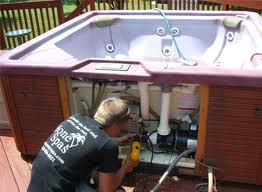
A well-maintained spa or hot tub has many moving parts, including a heater, blowers, pumps, filtration system, and electrical circuits among others. The electrical system runs all the others, so it can be frustrating when it stops working. If your hot tub trips the breaker and shuts off, you can do some simple troubleshooting to identify the problem, but be very careful when working with your hot tub’s electrical system. Electricity and water are a dangerous combination, so if you are not familiar with electrical systems and troubleshooting, please contact a professional to assist you.
To start with, your hot tub is probably plugged in to a GFCI (ground fault circuit interrupter) breaker or outlet. This kind of outlet has test and reset buttons and is usually found in areas where water may come in contact with the circuit that can shut itself off in case of electrocution. This outlet can sense when an electrical current passes to the ground, as it would through a human being if someone was being electrocuted, and shuts itself off.
There are many reasons your hot tub could be tripping the breaker, because even well-kept hot tubs and spas can develop small issues that will turn into bigger issues if left unattended. Because the main element of a hot tub is of course water, the electrical components need to be kept dry and clean. Checking connections and wires as part of regular maintenance will help keep your hot tub from tripping the breaker.
These are some of the most common potential threats to keep an eye out for while taking care of your spa:
- Moisture in the control box
- Corrosion on all contacts
- Faulty heat element
- Overheated wire connections
- Loose spade connections or poor crimp connections
- Secure GFCI breaker mounting tags
If you find that your hot tub trips the GFCI breaker at seemingly random times, use a process of elimination to determine what is causing the power outage. Check your outlet and make sure the plug is firmly inserted.
First, disconnect everything from the GFCI breaker. If it still trips that tells you the problem in with the breaker itself.
Second, disconnect one component at a time from the breaker until you can recreate the trip: light, blower, pump, filter, etc. The culprit component will be the one that trips the break during this test.
Third, if step two didn’t reveal any issues, disconnect one wire at a time to isolate the source of the problem.
If you have some experience with wiring, you may be able to fix the problem once it’s identified, but it’s always a good idea to have a local electrical professional on hand to help.
JavaScript seems to be disabled in your browser. For the best experience on our site, be sure to turn on Javascript in your browser.

- Air Controls
- Balboa Circuit Boards
- Balboa Heaters
- Balboa Jets
- Balboa Temperature Sensors
- Balboa Topside Controls
- Balboa Transformers
- Circuit Boards
- 50hz European Spa Parts
- Hot Tub Covers and Lifters
- Miscellaneous
- Sundance Spa Parts
- Topside Controls
- Waterfall Parts
- Home
- Category View - Grid
- Category View - List
- Product
- Blog
Why HotTub Keeps Tripping Breaker

T here's nothing quite like immersing yourself in the warm, bubbling waters of a hot tub after a long day. The soothing jets, the calming ambiance, and the immediate relaxation are simply irresistible. But what if one day you're just about to step in and, all of a sudden, your hot tub trips the breaker? This can be absolutely frustrating, and not to mention, it leaves you with a myriad of questions. Is it dangerous? Can you fix it on your own, or do you need a professional? And most importantly, why does this keep happening?
In this blog post, we'll help you get to the bottom of this annoying issue. We will delve into the various reasons why your hot tub keeps tripping the breaker, along with some simple solutions and precautions you can take to ensure the breaker trips are kept to a minimum. So, let's dive in and find out what could be causing your hot tub oasis to transform into an electrifying headache.
1-Definition of hot tub
Understand the purpose: A hot tub is a large container filled with heated water used for relaxation, hydrotherapy, and socializing.
Recognize key features: Typically equipped with jets, seats, and temperature controls for a customized and comfortable soaking experience.
Know the types: Available in various designs, materials, and sizes, hot tubs can be categorized as portable, in-ground, or inflatable.
Keep in mind the benefits: hot tubs offer numerous physical and mental health advantages, including stress relief, muscle relaxation, and improved sleep.
Remember the importance of maintenance: Proper care and upkeep are essential to ensuring the efficient functioning, durability, and safety of your hot tub.

2-Importance of hot tub maintenance
Maintaining your hot tub: the importance of regular care and attention.
- Enhance the longevity of your hot tub by performing routine maintenance
- Save on costly repairs and replacements through early detection of issues
- "A well-maintained hot tub is a long-lasting and enjoyable investment." - Anonymous
- Ensure safety for users by addressing electrical issues such as breaker tripping
- Keep water clear and hygienic, enhancing your hot tub experience
- Limit the possibility of corrosion, protecting vital hot tub components
- Regular maintenance checks also help you identify and resolve moisture issues, preventing damage and enhancing performance

3-The common issue of hot tub tripping the breaker
How to guide: addressing common hot tub breaker tripping issues.
1. Turn off the power supply: Always switch off the main power supply before inspecting any electrical components.
2. Visual inspection: Look for signs of wear and tear, such as a cracked or broken switch.
3. Flip the breaker: If the breaker trips immediately after being flipped, it might be a worn or damaged breaker.
4. Disconnect devices: Disconnect all devices from the GFCI and try flipping them again. If it still trips, this indicates a need for breaker replacement.
5. Consult a professional: Reach out to a licensed electrician for an expert assessment and potential replacement of the breaker.
6. Consider preventative measures: Install surge protectors and regularly maintain your hot tub to avoid a worn GFCI breaker in the future.

4. Moisture in Your Hot Tub Breaker Box
Definition of hot tub.
Hot tubs are small pools or large tubs filled with heated water, often used for relaxation, hydrotherapy, or leisure activities. They are designed with seating arrangements, jet systems, and temperature controls to cater to the users' preferences.
Importance of hot tub maintenance
Maintaining your hot tub is essential for ensuring its longevity, optimal performance, and safety. Regular maintenance helps to prevent various issues, including water imbalances, equipment malfunctions, and unsanitary conditions, making the hot tub experience more enjoyable.
The common issue of hot tub tripping the breaker
A hot tub tripping the breaker can be attributed to several issues, including:
A. Worn Hot Tub GFCI Breaker
A ground fault circuit interrupter (gfci) is a safety device that protects against electrical shocks. over time, a gfci may wear out and trip the breaker without any faults., b. moisture in your hot tub breaker box.
How to Prevent Moisture in Your Hot Tub Breaker Box:
Routinely inspect the breaker box for any water leaks or signs of condensation
Seal any gaps or cracks to prevent moisture from entering
Ensure proper ventilation to avoid dampness
Use watertight electrical components designed for use in wet environments
C. Corrosion in Hot Tub Components
Corrosion can affect electrical components, leading to a higher risk of short circuits, degraded performance, and breaker trips. Regularly clean and inspect components, and replace corroded parts promptly.
D. Faulty Hot Tub Heating Element
A malfunctioning or damaged heating element could overheat and cause the breaker to trip. Replacing the faulty component can solve the problem.
E. Overload in the Circuitry
An overloaded circuit can trip the breaker. Ensure that the hot tub is on a dedicated circuit, and avoid using multiple high-power devices simultaneously.
F. Ground Fault in the Wiring
A ground fault occurs when electrical current leaks into the ground. Inspect wiring for damages and repair to prevent dangerous ground faults.
A. Regular Maintenance Routine
Implement a comprehensive hot tub maintenance routine, including water chemistry, filter cleaning, and inspection of electrical components for wear and tear.
B. Hire a Professional Electrician
Seek professional assistance for complex electrical issues, installations, and preventive maintenance to ensure the safety and proper functioning of your hot tub.
C. Install Additional Protection Devices
Consider installing surge protectors and Ground Fault Circuit Interrupter (GFCI) devices to add an extra layer of protection to your hot tub systems.
Importance of addressing hot tub issues immediately
Promptly addressing hot tub issues can prevent more severe problems, reduce the risk of personal injuries, and avoid costly repairs. It also helps maintain the hot tub’s performance, ensuring a comfortable and satisfying experience.
Benefits of maintaining a well-functioning hot tub
A well-maintained hot tub offers numerous benefits, including better hygiene, lower energy consumption, increased durability, and better relaxation. Moreover, it prevents unnecessary stress on the electrical system and keeps the hot tub safe for users.

5. Corrosion in Hot Tub Components
How to guide: preventing and addressing corrosion in hot tub components.
Regularly inspect your hot tub components for signs of corrosion, such as whitish powder or rust around connectors
Keep an eye out for malfunctioning components, as this may be due to corrosion affecting their performance
Clean corroded connectors and components using a soft brush, and apply a corrosion inhibitor if recommended by the manufacturer
Consider replacing heavily corroded parts to prevent further damage and ensure optimal hot tub functioning
Schedule regular maintenance to catch any potential corrosion issues early on and extend the lifespan of your hot tub components

6. Faulty Hot Tub Heating Element
How to identify and fix a faulty hot tub heating element:.
Shut off all power: Before beginning any inspection or repair, ensure that all power to the hot tub is completely shut off at the service panel.
Disconnect heater wires: Carefully disconnect the copper tabs or wires from the spa pack to the heater element.
Test voltage: Utilize a multimeter to test the voltage on the heater element leads. For 240V spas, a reading of 240V indicates a faulty element, while a reading of zero points to an issue with the circuit board. For 120V spas, a reading of 120V indicates a faulty element and zero indicates a circuit board issue.
OHMs test: Alternatively, perform an OHMs test to check the resistance of the heater element. Set the multimeter to the OHM setting and test both leads on the heater element. A reading of 9-14 OHMs indicates a likely functional element, while an open or nonexistent reading suggests a faulty element
Replace faulty component: If your inspection determines that the heater element is indeed faulty, consider replacing either the element itself or the entire heater assembly if it's more than a few years old.
Remember that dealing with electricity can be dangerous, so hiring a professional electrician is always recommended for any electrical repairs, especially when working around water.

7. Overload in the Circuitry
How to prevent overload in hot tub circuitry.
To ensure the smooth functioning of your hot tub and avoid breaker trips due to circuit overload, follow these steps:
Assess your electrical system: Determine if your hot tub is properly connected to an adequate power supply that meets its requirements.
Don't overtax the circuit: Avoid plugging in additional electrical devices to the same circuit as your hot tub.
Schedule regular inspections: Have a professional electrician periodically check your hot tub's circuitry for issues and maintain optimal performance.
By taking these precautions, you can significantly reduce the risk of circuit overload and enjoy a well-functioning hot tub.

8. Ground Fault in the Wiring
How to guide: addressing ground faults in hot tub wiring.
Start by switching off the hot tub's main electrical supply for safety.
Inspect cables for any visible damages, exposed wires, or loose connections.
Arrange for a professional electrician to perform a thorough inspection of the hot tub's wiring system.
Implement any recommended repairs or replacements promptly to ensure a safe and efficient functioning hot tub.
Consider installing additional protection devices like surge protectors, as recommended by an electrician.
Follow a consistent maintenance routine for the electrical components of your hot tub.

9. Regular Maintenance Routine
A regular maintenance routine for your hot tub.
To ensure the optimal performance and longevity of your hot tub, it is crucial to establish a regular maintenance routine. Consider these essential steps for maintaining your hot tub:
nspect hot tub components periodically for signs of corrosion, such as rust or white powder.
Check the GFCI breaker and breaker box for moisture or damage.
Schedule professional electrician visits for a thorough inspection of electrical systems and wiring.
Clean and replace filters as recommended by the manufacturer.
Balance hot tub water chemistry as part of your weekly maintenance routine.
Protect your hot tub from power surges by installing additional protection devices.

Real email address is required to social networks
How to Troubleshoot If Your Hot Tub is Tripping the Breaker
A hot tub provides excellent relaxation and therapeutic benefits, but in the rare situation that your circuit breaker is tripping, it’s important to understand what steps can be taken to resolve it. Here are five easy fixes you can apply when your hot tub is tripping your circuit breaker:
1. Get Rid of Any Moisture in the Breaker Box
Without a doubt, water is an essential part of the hot tub experience. However, when it comes to the electrical components of a hot tub, water should be nowhere present. For safety reasons, your breaker box has the protective function of automatically turning off whenever there’s moisture, even in the slightest bit.
Once you’ve suspected that moisture might be the culprit, an easy fix would be to get rid of it. First, turn off the main electrical supply. Then, open the breaker box and carefully check for signs of water. If you find any, use a towel or any absorbent cloth to wipe it off, then use a fan near the outlet to make sure it’s completely dry. After that, you can go ahead and reset the breaker.
Of course, it’s better if you prevent any moisture from getting into the panel in the first place. You can do this by keeping the rubber seal intact and the cables sealed tight. If you’re sure that the breaker is dry, but flipping still occurs, there might be a need to replace the receptacle.
2. Replace Your Old GFCI Breaker
Tripping can also happen if your ground fault circuit interrupter (GFCI) is no longer in good condition. Even though they are designed to last long and withstand continued use, they can still get worn out eventually. If this is the case, you might need to get a new breaker.
To find out if a replacement is in order, you can try a quick test. Start with switching on the hot tub circuit breaker. If it suddenly trips again, remove any remaining connections from the breaker. Next, try flipping the GFCI breaker back on. If it trips again, you can confirm that the breaker itself is the issue. If there’s no tripping, then something else is causing the problem.
3. Secure All Wiring Connectors
When there are circuit interruptions that cause tripping, one of the issues you might want to check is the presence of any loose wiring. Wiring connectors can come loose due to old age or any motion caused by external factors. Unsecured wires typically result in power fluctuations, which can then cause your hot tub’s breaker to trip.
In this scenario, the best thing to do is to get in touch with a licensed electrician to inspect your hot tub’s wiring system. As for plastic plug-in connectors that you might have on your hot tub, an easy fix would be to push them securely back into place.
4. Switch Out Your Hot Tub’s Heater
If your hot tub’s heater shows any sign of corrosion or damage, then getting a new one might be the solution. A heater that’s not in the best shape can also cause the circuit breaker to trip.
Take a look at the heating component and find out what kind of damage it might have. Do you see any rust, white powder, or other signs of corrosion? If there’s no visible sign of any deterioration, you can try running a quick test. Simply disconnect the heater from the control box and switch on the breaker. You can be sure that the heater was the issue if the breaker remains switched on. If that’s the case, you can fix the tripping problem with a replacement.
5. Take Measures to Prevent Short Circuits
Because breakers are designed to trip for safety reasons, your hot tub is bound to trip the breaker in the event of a short circuit. Short circuits can easily be avoided by checking if all the connections in your hot tub are secure and ensuring that no moisture has seeped into the breaker box. You can test if there’s an unsecured connection by unplugging all the wires then connecting them back one at a time to find out if any of them aren’t properly working. You can also prevent short circuits by making sure that all the electrical components in your hot tub are completely dry.
Now that you know the possible reasons why your hot tub could be tripping the circuit breaker, you can do a little troubleshooting and test out these easy fixes. Don’t let a small electrical problem ruin your hot tub experience – try these tips and get back to relaxing in no time!
FREE HOT TUB BUYERS GUIDE
To learn how to select the perfect hot tub, download your free buyer’s guide now by clicking below!
Leave a Reply
Your email address will not be published. Required fields are marked *
SAVE UP TO $4500 ON HOT TUBS AND UP TO $6000 ON SWIM SPAS!
×
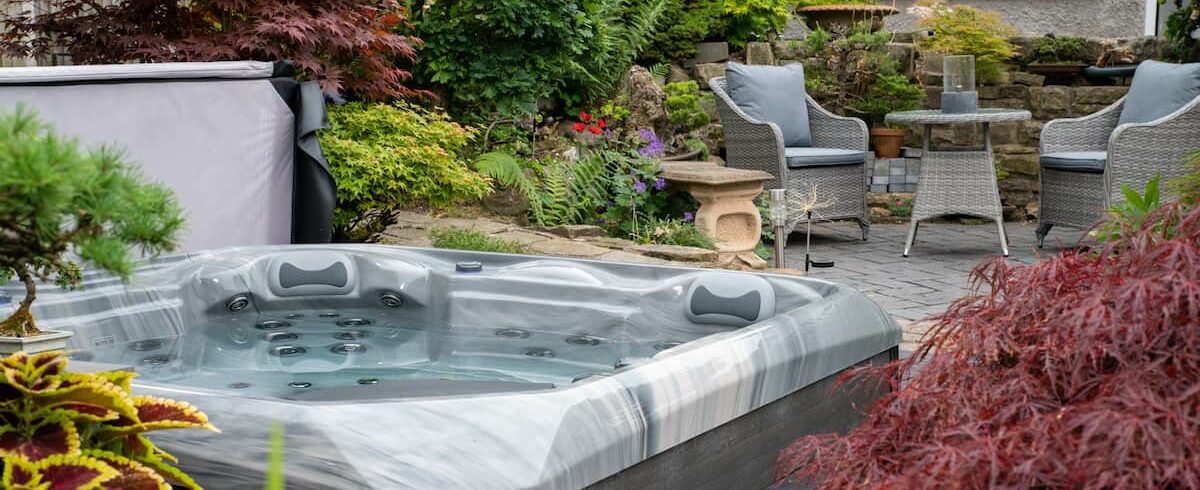
Reasons Why Your Hot Tub Breaker Keeps Tripping
If your hot tub breaker keeps tripping, it can be inconvenient and concerning, leaving you wondering what’s wrong with your hot tub , and why it’s not drawing power. There’s not just one reason why the breaker keeps tripping: it could be the result of a number of different issues, ranging from minor ones that are easily solved to more severe ones that may be a bad sign for your hot tub’s longevity.
In this guide, we’re going to have a look at why your breaker might be tripping and what you can do to solve it. Are you ready to get started and get your hot tub back in working order? Then read on!
How to Know Your Hot Tub Is Tripping the Breaker
It can be difficult to know whether it’s your hot tub tripping the breaker, or if it’s something else. Thankfully, it’s not too difficult to find out. Near your hot tub, there should be a metal box with a black switch, which is your hot tub’s GFCI breaker. If it’s flipped, it can mean that your tub experienced an electrical surge, which trips the breaker as a safety measure.
However, it does not always mean that there’s a dangerous issue at hand – it can be the result of other issues, too. In this guide, we’re going to have a closer look at some of these issues and what you can do to solve them.
If you are not completely comfortable working with electrical systems, you should hire an electrician rather than do it yourself. If you do work on it yourself, be sure to follow all relevant safety advice.
6 Reasons Why Your Hot Tub Breaker Keeps Tripping
There are six common causes why your hot tub breaker keeps tripping:
- Your breaker may have worn out
- Faulty installation
- Moisture within the breaker itself
- Issues with the heater
- Issues with components
- Air blower malfunctions
1. Your Breaker May Have Worn Out
Circuit breakers don’t last forever, and it’s possible that age, previous power surges, or a combination of these and other factors have simply worn your breaker out. This can cause it to permanently be stuck in the flipped position. This is easy to diagnose: try flipping the breaker back up – does it flip back down immediately?
If it does, your breaker has likely simply worn out, and you’ll need to replace it.
2. A Case of Faulty Installation
If your hot tub is brand new, it’s less likely that your breaker tripped due to wearing out. However, it could be the case that the wiring on your hot tub was badly installed. It’s possible that, for example, there is an issue with your hot tub’s grounding, resulting in electricity flowing through your tub’s water rather than into the ground wire.
Another issue that can result from bad installation involves loose electrical connections. If connections in your hot tub are loose, it could cause significant fluctuations in power, which can trip the breaker.
3. Moisture Within the Breaker Itself
If there’s moisture within the breaker itself this will result in the breaker tripping at regular intervals. Your breaker should have a seal that can keep moisture out, but this can break or otherwise become less effective over time. When the seal has broken, moisture and water can find its way inside the breaker box, which will make it trip, as well as causing rust, which in itself can lead to many other issues.
If there’s moisture inside the breaker box, you will need to change the seal, which should solve your issue.
4. Issues With the Heater
The heater can be the cause of a tripped circuit breaker, especially if parts of the heater have corroded. The heating element is the usual suspect and if it’s corroded or broken, you’ll need to replace the heater. One way to test if this part is responsible is to unplug the heater and then flip the breaker up. If it works normally, then the heater will be at fault.
Replacing the heater isn’t too difficult a task, but it’s not something you should attempt yourself unless you’re comfortable working with electrics.
5. Issues With Components
Your issue could also come down to faulty components, particularly accessories. For example, if you have a set of LED lights, or a sound system, or similar, these components could be causing the hot tub to trip. You can diagnose the offending parts by unplugging all of them and then replugging them in one by one. The circuit breaker should trip at the offending part and not before.
Then it’s a matter of replacing that particular part and checking that the circuit breaker doesn’t trip any more.
6. Air Blower Malfunctions
Another core component of your hot tub that could be causing issues is your air blower. This is an important part of your hot tub, as it is what forces air into the hot tub and makes the bubbles that make your hot tub so enjoyable to use.
If this floods, due to failed valves or other issues, it can make your circuit breaker trip. It’s possible to fix an air blower that’s flooded just by letting it dry and then refitting it, but it can cause severe rust that will ruin the component. If that’s happened, you’ll need to replace the air blower, which can be a highly complex job.
We hope that you’ve found this guide on why your hot tub breaker keeps tripping helpful. We’ve listed the most common causes that could be affecting your breaker, but this list is not exhaustive, and some rare problems could also be resulting in a tripped breaker.
If you’ve looked at this list and your problem remains unresolved, you may need to call out a professional technician to have a look at your hot tub and uncover the root cause of the problem. At Platinum Spas, we can help you answer your questions – contact us today and our expert team will be happy to assist you.
- Recent Posts
- Mental Health Awareness Week: How Hot Tubs Can Help - 02/05/2024
- Hot Tub Chemicals for Beginners - 28/02/2024
- How Much Do Swim Spas Cost? - 06/02/2024
Other Articles
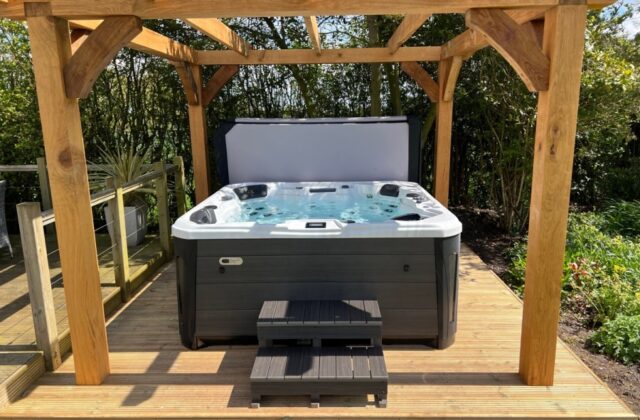
Mental Health Awareness Week: How Hot Tubs Can Help
Introduction Mental Health Awareness Week takes place from 13 – 19 May, so we have created a blog that shares how hot tubs can help improve mental health through easing …
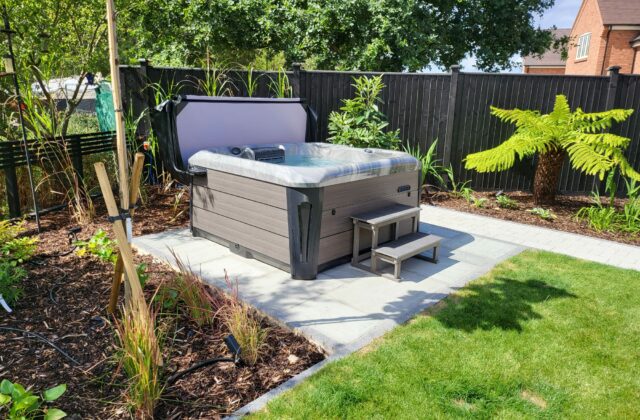
Platinum Spas wins ‘Approved Manufacturer’ status from leading hot tub and swim spa magazine
We’re thrilled to announce that we have been approved as a WhatSpa? and WhatSwimSpa? 2024 hot tub and swim spa manufacturer for the sixth year in a row. As Europe’s …
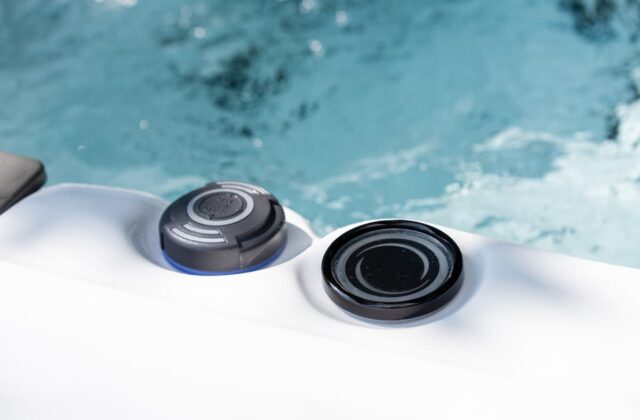
How to Clean a Hot Tub Filter: A Complete Guide
As a proud hot tub owner, you’re probably wondering how you can look after your new prized possession for years to come. There are many facets to hot tub maintenance, …
Browswer unspported. To enjoy our website to the fullest, please update or use another browser.

Why Does My Hot Tub Trip the Breaker When the Jets Are On?
By: Author Jeff Campbell
Posted on Published: September 28, 2023 - Last updated: September 29, 2023
Categories Hot Tub Repair
Relaxing in a hot tub can be a great way to unwind and soothe sore muscles. The jets obviously use more power when they’re on, but they shouldn’t be causing the breaker to trip. So if that’s happening, you’re likely wondering “why does my hot tub trip the breaker when the jets are on?”
When your hot tub trips the breaker when the jets are on, it’s typically due to an electrical overload. Jet pumps draw substantial power, and issues like a faulty pump, clogged jets, or electrical problems can lead to this.
To ensure safety and proper function, consult a qualified technician for diagnosis and repair.
This common issue can be frustrating and even dangerous if not addressed promptly. In this section, we will explore the reasons why hot tubs trip the breaker when the jets are turned on. We’ll provide valuable safety tips, a comprehensive troubleshooting guide, and expert solutions to help you ensure your hot tub is functioning correctly.
- Hot tubs tripping the breaker when the jets are turned on is a common issue that can be dangerous if not addressed.
- Following hot tub safety tips, such as ensuring proper electrical components and consulting a professional electrician, is crucial.
- A thorough troubleshooting guide can help identify the electrical problems causing the breaker to trip.
- Expert solutions include checking the control box and hot tub components, addressing common problems like GFCI trips, and consulting a qualified electrician for complex issues.
- If in doubt, always consult a licensed electrician to ensure the safety and longevity of your hot tub.
Hot Tub Safety Tips
Hot tubs are a relaxing and enjoyable addition to any home, but they require proper maintenance to ensure safety and prevent accidents. Here are some essential hot tub safety tips to keep in mind:
- Electrical components: Hot tubs rely on electricity to function, so it’s crucial to ensure all electrical components are in good working order. A malfunctioning ground fault circuit interrupter (GFCI) can be a potential safety hazard, so it’s best to have a professional electrician inspect all electrical connections regularly.
- Regular maintenance: Keeping your hot tub clean and well-maintained is crucial for preventing accidents and ensuring its longevity. Regularly checking for wear and tear on the cover, steps, and handrails can help prevent slips and falls.
- Proper usage: Always read and follow the manufacturer’s instructions for using your hot tub. Never allow children to use a hot tub unsupervised, and never use a hot tub while under the influence of alcohol or drugs.
- Water safety: It’s important to maintain proper chemical levels to prevent the growth of harmful bacteria. Always shower before using the hot tub and avoid swallowing the water.
By following these hot tub safety tips and ensuring proper installation and maintenance of electrical components like the GFCI, you can enjoy a relaxing and safe hot tub experience.

If your hot tub’s breaker keeps tripping when the jets are turned on, it’s time to troubleshoot. Here’s what you can do:
- Check the Topside Control Panel: Start by inspecting the control panel of your hot tub. Look for any visible signs of damage or wear and tear. Check that all buttons and switches are working correctly, and there are no loose wires or connections.
- Inspect the Circuit Board Inside the Spa Pack: If the control panel looks fine, the next step is to inspect the circuit board. This board controls all the electrical components of your hot tub, so it’s essential to ensure that it’s working correctly. Look for any damaged parts or signs of corrosion and replace them if necessary.
- Address Electrical Problems: Your hot tub’s breaker may trip due to electrical issues like faulty wiring or improper installation. Check all electrical connections and wiring to ensure they are secure and free from damage. It’s better to call a licensed electrician to diagnose and rectify electrical problems.
- Consider Power Surges: Power surges can happen during a storm or due to electrical malfunctions. These surges can cause hot tubs to trip their breakers. Install a surge protector or turn off the hot tub’s power during storms to prevent this from happening.
By following this troubleshooting guide, you can identify and solve most hot tub breaker tripping issues related to the control panel, the circuit board, electrical problems, and power surges. If none of these steps solve the problem, consider seeking the help of a qualified electrician.

Now that you’ve identified the cause of your hot tub breaker tripping, it’s good to find the most effective way to resolve it. Remember to check the control box and other hot tub components, find the most common problem such as GFCI trips, and consult a qualified electrician if needed.
If it’s been a while since the last time you inspected your hot tub’s control box, it’s a good idea to take a look inside and see if there are any loose connectors or damaged wires. You can also test the hot tub components such as the pump, heater, and filter to check if they’re functioning correctly.
If you suspect that GFCI trips are a common problem, check the hot tub’s electrical connections and ground wire for any faults. It’s also essential to ensure that the check valve is in good condition and working correctly to prevent backflow and protect the pump from damage.
Hot tub owners should remember that some issues, like a bad heating element or non-return valve, may require a process of elimination to identify the cause of the problem. If you’re unsure about any electrical issues or installations, consulting a licensed electrician is always the best way to go.
With these expert solutions, you’ll be able to troubleshoot and fix hot tub breaker tripping, ensuring that you can enjoy your hot tub safely and without any worries.

Hot tub breaker tripping when the jets are turned on can be caused by various factors, such as faulty components, electrical issues, or improper installation. By following the safety tips, using the troubleshooting guide, and seeking expert assistance if needed, you can resolve this issue and enjoy a properly functioning hot tub.
To address potential causes like white powder, check valves, heater terminals, bad heating elements, and non-return valves, you should go through a process of elimination. Start with the most common reasons and work your way down. If you’re unsure about anything, consult a licensed electrician to ensure the safety and longevity of your hot tub.
Remember to check the ground wire and connections for loose or damaged wires and make sure the spa pack is installed correctly. And if your GFCI keeps tripping, it may be an indication of a bad heating element or a faulty component.
In summary, the best way to resolve hot tub breaker tripping is by addressing the cause of the problem. Follow the troubleshooting guide, check every hot tub component carefully, and seek expert assistance from a licensed electrician if needed. By doing so, you’ll be able to enjoy your hot tub properly and safely for years to come.
Q: Why does my hot tub trip the breaker when the jets are on?
A: This issue is commonly caused by electrical problems or faulty components. It’s important to follow safety tips, use a troubleshooting guide, and consult a licensed electrician if needed to resolve this problem.
Q: What are some hot tub safety tips?
A: Ensure that your hot tub has proper electrical components, such as a ground fault circuit interrupter (GFCI). Additionally, it’s crucial to consult a professional electrician for any electrical connections.
Q: How can I troubleshoot my hot tub when the breaker keeps tripping?
A: Start by checking the control panel, circuit board, and power surges. Follow a step-by-step troubleshooting guide to identify and address the underlying electrical issues.
Q: What are some expert solutions for hot tub breaker tripping?
A: Expert solutions include checking the control box, inspecting hot tub components, addressing common problems like GFCI trips, and consulting a qualified electrician for complex issues.
Q: What are the most common reasons for hot tub breaker tripping?
A: The most common reasons include faulty components, electrical issues, or improper installation. It’s important to address potential causes such as white powder, check valves, heater terminals, bad heating elements, and non-return valves through a process of elimination. If in doubt, consult a licensed electrician.
- Recent Posts
- Relxtime 6 Person Square Inflatable Hot Tub (2024 Review) - March 11, 2024
- Hot Tub Cover Mold – Complete Cleaning Guide - February 20, 2024
- Hot Tub Heater Longevity: How Often Should You Replace? - December 14, 2023
- 856-661-0043
- Gift Certificates
- My Account
- Sign in or Create an account
Currency Displayed in

Tech Support

$4.99 Flat Rate shipping!
- Shipping & Returns
- Beachcomber Hot Tubs
- Balboa Spa Equipment
- Bull Frog Spas
- Caldera Spas
- Coleman Spas
- Dimension One Spas
- Dynasty Spas
- Emerald Spas
- Freeflow Spas
- Gecko Spa Manuals
- Hot Spot Spas
- Home & Garden Spas Owners Manual
- Hot Spring Spas
- Jacuzzi Spas
- Marquis Spas
- Master Spas
- Saratoga Spas
- Sundance Spas
- Tiger River Spas
Spa / Hot Tub GFCI Breaker TrippinG?
- Spa Cover Lifters
- Spa Railings
- Spa Booster Seats
- Spa Tablet Floaters
- Spa Thermometers
- Spa Test Strips
- Spa Pre-Filters
- Spa Skimmers and Nets
- Spa Cleaning Supplies
- Spa Tools / Gadgets
- All Other Accessories
- Spa Air Blowers
- Spa Air Buttons
- Spa Air Controls by Hydro Air
- Air Controls by Waterway Plastics
- CMP Air Controls
- Spa Air Controls by GG Industries
- Pentair Spa Air Controls
- Cal Spa Air Controls
- Artesian Spa Air Controls
- Catalina Spa Air Controls
- Coast Spas Air Controls
- Coleman Spas Air Controls
- Dynasty Spa Air Controls
- Jacuzzi Spa Air Controls
- LA Spas Air Controls
- Marquis Spa Air Controls
- Pinnacle / Premium Leisure Air Controls
- Master Spas Air Control
- Sundance Spa Air Controls
- Tecmark Tridelta Spa Air Switches
- Pres Air Trol Spa Air Switches
- Len Gordon Spa Air Switches
- Herga Spa Air Swicthes
- Allied Innovations Spa Air Switches
- 1/8"I.D. Clear Air Tubing
- Waterway Plastics Spa Injectors
- Hydro Air Spa Air Injectors
- Cal Spa Air Injectors / Parts
- GG / Balboa Spa Air Injectors
- Spa Air Blower Check Valves
- Test Kits & Strips
- Sanitizers / Shock Treatments
- Water Treatments
- Maintenance / Cleaning
- Spa Chemical Startup Kits
- Mineral Purifiers / Alternatives
- Frog Spa Products
- Brett Aqualine
- Catalina Spas Circuit Boards
- Coleman Spas Circuit Boards
- Free Flow Spas
- Hawkeye Spas
- Leisure Bay Spas
- Nordic Spas
- Phoenix Spas
- Spa Builders Spa Circuit Boards
- Southwest Spas
- Aqua-Flo Spa Circulation Pumps
- Waterway Circulation Pumps
- Grundfos Circulation Pumps
- Laing Circulation Pumps
- Master Spa Circulation Pumps
- Sundance / Jacuzzi Circ Pumps
- LX Spa Circulation Pumps
- Balboa / Vico Spa Circulation Pumps
- Saratoga Spa Circulation Pumps
- Catalina Spas Mister Pump
- Cal Pumps Spa Circulation Pumps
- Single Pole Contactors
- Double Pole Contactors
- Triple Pole Contactors
- ACC Applied Computer Controls Spa Topside Controls
- Artesian Topside Control Panels
- Balboa Topside Control Panels
- Brett Aqualine Spa Topside Control Panels
- Bull Frog Topside Control Panels
- Caldera Spa Topside Control Panels
- Catalina Spa Control Panels
- Cal Spas Topside Control Panels
- Coast Spas Topside Controls
- Correct-Tech Topside Control Panels
- Coleman Spas Topside Control Panels
- Dimension One Spas Topside Control Panels
- Dynasty Spas Topside Controls
- Free Flow Spas Topside Control Panels
- Gecko Spa Topside Control Panels
- Hawkeye Spas Topside Control Panels
- Hot Springs Spas Topside Control Panels
- Hydro-Quip Spa Topside Control Panels
- Hydro Spas Topside Control Panels
- Jacuzzi Spas Topside Control Panels
- L.A. Spas Topside Control Panels
- Leisure Bay Spas Topside Control Panels
- Len Gordon Spa Topside Control Panels
- Master Spas Topside Control Panels
- Marquis Spas Topside Control Panels
- Nordic Spas Topside Control Panels
- Pres-Air Spa Control Panels
- Saratoga Spa Topside Control Panels
- Spa Builders Spa Topside Control Panels
- Sundance Spa Topside Control Panels
- Tecmark / Tridelta Spa Topside Control Panels
- Thermo Spas Topside Control Panels
- Waterway Spa Topside Control Panels
- Vita Spa Topside Control Panels
- Balboa Spa Controls
- Spa Builders Controls
- Hydro-Quip Controls
- Applied Computer Control Packs
- Allied Innovations Spa & Bath Controls
- LA Spas Control Systems
- Spa Cover Cap
- Spa Fuses and Holders
- Plugs & Receptacles
- Balboa Spa Transformers
- Vita Spa / DM Industries Transformers
- Spa Ground Fault Breakers / GFCI Cords
- Spa Rocker Switches
- Balboa Spa Equipment Systems
- Spa Builders Support Group
- Hydro-Quip Spa Equipment Systems
- Outdoor Equipment Packs
- Baptismal Spa Equipment Systems
- @ Home Hot Tubs Cartridge Filters
- Alps Spas Cartridge Filters
- Artic Spas Cartridge Filters
- Artesian Spas Cartridge Filters
- Baja Spas Cartridge Filters
- Barefoot Spas Cartridge Filters
- Beachcomber Spas Cartrdige Filters
- Blue Ridge Spas Cartridge Filters
- Bull Frog Spas Cartridge Filters
- Cal Spas Cartridge Filters
- Calderra Spas Cartridge Filters
- California Cooperage Spas Cartridge Filters
- Catalina Spas Cartridge Filters
- Clearwater Spas Cartridge Filters
- Coast Spas Cartridge Filters
- Coleman Spas Cartridge Filters
- Dakota Spas Cartridge Filters
- Del Sol Spas Cartridge Filters
- Diamante Spas Cartridge Filters
- Dimension One Spas Cartridge Filters
- Downeast Spas Cartridge Filters
- Dream Maker Spas Cartridge Filters
- Dynasty Spas Cartridge Filters
- Dr Wellness Spas Cartridge Filters
- Emerald Spas Cartridge Filters
- Everyday Hot Tubs Cartridge Filters
- Fountain Valley Spas Cartridge Filters
- Free Flow Spas Cartridge Filters
- Garden Leisure Spas Cartridge Filters
- Gatsby Spas Cartridge Filters
- GPM Industries / Great Lakes Cartridge Fiiters
- Gulf Coast Spas Cartridge Filters
- H20 Spas Cartridge Filters
- Hawkeye Spas Cartridge Filters
- Hayward Spa Cartridge Filters
- Hot Springs Spas Cartridge Filters
- Hydro Spa Cartridge Filters
- Icon Spas Cartridge Filters
- Image Spas Cartridge Filters
- Jacuzzi Premium Spas Cartridge Filters
- L.A. Spas Cartridge Filters
- Leisure Bay Spas Cartridge Filters
- Maax Spas Cartridge Filters
- Marquis Spas Cartridge Filters
- Master Spas Cartridge Filters
- Nordic Spas Cartridge Filters
- PDC Spas Cartridge Filters
- Pentair Cartridge Filters
- Phoenix Spas Cartridge Filters
- QCA Spas Cartridge Filters
- Rainbow Plastics Cartridge Filters
- Rec Warehouse
- Rocky Mountain Spas Cartridge Filters
- Royal Spas Cartridge Filters
- Safari Spas
- Santa Barbara Spas Cartridge Filters
- Saratoga Spas Cartridge Filters
- Signature Spas Cartridge Filters
- Softsider Spas Cartridge Filters
- Softub Spas Cartridge Filters
- Sonoma Spas Cartridge Filters
- Spa Crest Spas Cartridge Filters
- Spa in a Box Cartridge Filters
- Streamline Spas Cartridge Filters
- Strong Industries Cartridge Filters
- Sundance Spas Cartridge Filters
- Sunrise Spas Cartridge Filters
- Sunset Spas Cartridge Filters
- Superior Spas Cartridge Filters
- Thermo Spas Cartridge Filters
- Tiger River Spas Cartridge Filters
- Tranquility Spas Cartridge Filters
- Viking Spas Cartridge Filters
- Warm Springs Spas Cartridge Filters
- Waterway Plastics Cartridge Filters
- Watkins Spas Cartridge Filters
- Weslo Spas Cartridge Filters
- Waterway Plastics Spa Filter Assemblies / Parts
- Hayward C-225 Spa & Pool Filter System / Parts
- Hayward Cartridge Filter Systems / Parts
- Rainbow / Pentair Spa Filter Assemblies / Parts
- Coleman Spas Filter Parts
- Hayward C-250 & C-500 Spa Filter / Parts
- Great Lakes Spa Skimmer Filter Parts
- Jacuzzi/Sundance Filter Parts
- Various Spa Filter/Skimmer Parts
- Spa Filter Lids
- Flow Thru Spa Heater Elements
- Flange Style Spa Heater Elements
- Coil Style Heater Elements
- Screw Plug Spa Heater Elements
- Hair Pin Style Spa Heater Elements
- Flo Thru Spa Heater Assemblies
- Flow Thru: Tee Shaped Spa Heaters
- Low Flow: Tube Assembly Spa Heaters
- Low Flow Spa Heater Assemblies
- Flow Thru: Miscellaneous Spa Heaters
- Brett Aqualine / Len Gordon Plastic Spa Heater
- Spa Heater Parts and Accessories
- Spa Heater Manifolds / Housings
- Bath Heaters
- Waterway Adjustable Cluster Jets / Bodies
- Waterway Adjustable Cluster Storm Jet Bodies
- Waterway Adjustable Mini Jet Bodies
- Waterway Adjustable Mini Jets
- Waterway Cluster & Ozone Jet Bodies
- Waterway Cluster & Ozone Jets
- Waterway Master Massage Jets
- Waterway Mini Storm Jets
- Waterway Adjustable Cluster Storm Jets
- Waterway Poly Jets
- Waterway Poly Jet Bodies & Accessories
- Waterway Poly Storm Jets
- Waterway Power Storm Jets
- Waterway Standard Mini Jet Bodies
- Waterway Storm Jet Bodies
- Waterway Water Features / Jets
- Artesian Spa Jets
- Cal Spas Jets
- Catalina Spa Jets
- CMP Spa Jets 200 Series
- CMP Spa Jets 300 Series
- CMP Spa Jets 400 Series
- CMP Spa Jets 500 Series
- CMP Spa Jets 6" & Larger
- Coleman Spa Jets
- Dynasty Spa Jets
- Great Lakes Spa Jets
- Gulf Coast Spa Jets
- VERTA'SSAGE Spa Jets / Parts
- Thera'ssage Jet / Parts
- Hydro Air Spa VSR Jets / Parts
- Jacuzzi Spa Jets / Parts
- L.A. Spas Jets
- Master Spa Jets
- Pentair Balboa Jets / Parts
- Rising Dragon Spa Jets
- Sundance Spa Jets
- Sunrise Spa Jets
- Saratoga Spa Jets
- Vita Spa Jets
- Watkins, Hot Springs, Tiger River Jets
- Spa Jet Diffusers
- Replacement Bulbs / LED Lights
- Spa Light Lens Kits / Parts
- Spa Pump Motor Seals
- Spa Motor Capacitors
- Spa Pump Motor Bearings
- Spa O-Rings / Gaskets
- Water Pro Ozonators by Hydro-Quip
- Balboa Ozonators
- Dimension One Spas Ozone Products / Air Pumps
- Del Ozone Spa Ozonators
- Artesian Spa Pillows
- Bull Frog Spa Pillows
- Catalina Spa Pillows
- Coast Spas Pillows
- Coleman / Maax Spa Pillows
- Dynasty Spa Pillows
- Great Lakes Spa Pillows
- Hot Springs Spa Pillows
- Hydro Spa / Gulf Coast Pillows
- LA Spas Pillows
- Jacuzzi Spa Pillows
- Leisure Bay Spa Pillows
- Marquis Spa Pillows
- Master Spa Pillows
- Saratoga SpaPillows
- Sundance Spa Pillows
- Vita Spa Pillows
- Spa Pillows - Various Brands
- 3/8" Spa Manifolds Barb Style
- 1/2" Spa Manifolds
- 3/4" Ribbed Barb Spa Manifolds
- 3/4" Smooth Barb Manifolds
- 3/4" Spa Manifolds Slip Style
- 1" Spa Manifolds Slip Style
- Manifold Barb Fittings / Adapters
- Spa Gate Valves
- Waterway Diverter Valves / Parts
- Hydro Air Diverter Valves / Parts
- Caldera Diverter Valves / Parts
- Cal Spas Diverter Valves / Parts
- Catalina Diverter Valves / Parts
- CMP Spa Diverter Valves
- Coast Spas Diverter Valves / Parts
- Coleman / Maax Spa Diverter Valves / Parts
- Dimension One Spas Diverter Valves
- Dynasty Spa Diverter Valves and Parts
- Great Lakes Spa Diverter / On Off Valves
- Jacuzzi Spa Diverter Valves / Parts
- LA Spas Diverter Valves / Parts
- Master Spa Diverter Valves/Parts
- Marquis Spa Diverter Valves / Parts
- Saratoga Spa Diverter Valves / Parts
- Sundance Diverter / Shut Off Valves
- Vita Spa Diverter Valves / Parts
- Various Spa Valves and Parts
- Aqua-Flo Pump Unions, Assemblies / Components
- Waterway Pump Unions and Components
- Vico Pump Unions, Assemblies / Components
- Jacuzzi Pump Unions
- Hayward Pump Unions / Assemblies
- Magic Plastics Unions
- PVC Specialty Fittings / Repair Fittings
- 45 Degree Elbows
- 90 Degree Elbows
- Reducer Fittings
- Teflon Tape
- Spa Heater Unions and Components
- Spa Suctions
- Spa Skimmers
- Spa Strip Style Skimmers
- Clear Spa Tubing
- Spa Flex Pipe
- Tecmark / Tridelta Pressure Switches
- Len Gordon Pressure Switches
- Presair Pressure Switches
- Gecko Pressure Switches
- Balboa Pressure Switches
- Hydro Quip Spa Pressure Switches
- Cal Spas Pressure Switches, Flow, Vac
- Cal Spa Flow Switches
- Harwil Flow Switches
- Beachcomber Spas Flow Switches
- Sundance Spas Flow Switches
- Grid Controls Spa Flow Switches
- Waterway Executive Spa Pumps
- Waterway Center Discharge Spa Pumps
- Waterway Hi-Flo Spa Pumps
- Waterway Executive Pumps 56" Frame
- Waterway Center Discharge Pump Wetends / Parts
- Waterway Hi-Flo Pump Wetends / Parts
- Waterway Executive Pump Wetends / Parts
- Sundance / Jacuzzi Spa Pumps / Wetends / Parts
- Aqua-Flo 1.5" Side Discharge Pumps FMHP
- Aqua-Flo 1.5" Center Discharge Pumps FMCP
- Aqua-Flo 2" Side Discharge XP2 Spa Pumps
- Aqua-Flo 1.5" Side Discharge Pump Wetends / Parts
- Aqua-Flo 1.5 Center Discharge Pump Wetends/Parts
- Aqua-Flo 2" XP2 Pump Wetends and Parts
- LX Spa Pumps / Wetends / Parts
- Sta-Rite Spa Pumps / Wetends / Parts
- Balboa / Vico Spa Pumps / Wetends / Parts
- Coast Spa Pumps / Wetends
- Cal Spas Pumps
- Dreamaker Spa Pumps
- Vita Spa Pumps
- Dreamaker Spa Pumps / Parts
- Potter & Brumfield Closed Face Relays
- Ice Cube Style Relays
- Potter & Brumfield "S" Series Relays
- Zettler Omron T91 Series Relays
- Balboa Spa Temperature Sensors
- Gecko Spa Temperature Sensors
- Hydro-Quip Spa Temperature Sensors
- Sundance Spa Temperature Sensors
- Jacuzzi Spa Temperature Sensors
- Marquis Spa Temperature Sensors
- Coleman Spas Temperature Sensors
- Hot Springs / Watkins Temp Sensors
- CTI Correct-Tech Inc Spa Temp Sensors
- Caldera Spas Temperature Sensors
- Gatsby Blue Ridge Temperature Sensors
- Cal Spas Temperature Sensors
- Vita / Dm Spa Temperature Sensors
- Brett Aqualine Spa Temperature Sensors
- Maddox Spa Temperature Sensors
- Spa Sensor Mounts / Holders
- Spa Thermostats
- Spa High Limit Switches
- Grasslin Spa Timeclocks
- Diehl Spa Timeclocks
- Intermatic Spa Time Clocks
- Used / Refurbished Spa Parts
Posted by Spa Guy Dave on 1st Jan 2016
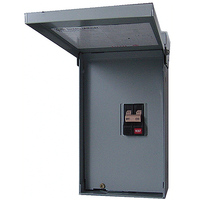
For Spa Service Technicians and Home Owners alike, one of the most common Hot Tub problems, is a GFCI Breaker that trips and will not reset. Many people make the mistake of calling their Electrician first and costing them a wasted service call fee. Or they rush out to the Big Box Store and plunk down a hundred bucks for a new GFCI Breaker, only to find out, once installed the new Breaker still trips.
The truth is 99% of the time when a GFCI Breaker trips, it is because it is working properly and is tripping due to a short somehwere in the Hot Tub's equipment.
So you ask, what is the most common cause of GFCI Breaker Trips? I have found that 85% of the time, it is caused by a bad Heater Element. With a bad Element, the breaker will usually trip very quickly, in many cases instantly. After attempting to turn on the breaker a few times, with it tripping each time. You can eliminate the Heater as the cause or confirm it is the culprit, with just a few steps.
First: Turn the Breaker off and test with a meter to be sure you have no power coming to the spa.
Second: On most Flo Thru Heaters, you will find 2) Heater Terminals, with a 3/8" Nut holding a copper strap or wire attached to the terminal from the Circuit Board. If you carefully loosen and remove each of the to 3/8" Nuts, then lift off the strap or Wire, therefore disconnecting the heater from the Circuit Board.
Third: Once the heater is disconnected, Turn the power breaker back on. If the breaker stays on and the spa starts up, you have confirmed the heater as the source of the problem. Your next step is to decide whether you would prefer purchasing the complete Heater Assembly with Stainless Tube or just the correct eater Element. Every spa is different, so there is not always a one size fits all answer. Check out the Ellements and Heater Assemblies here at Spa Parts Guy and compare, look for suggestion tips or contact us with your questions. We are happy to help you.
Soon you will be back in Hot Water!
Recent Posts
- » Low Flow Spa Heaters Are Back!
- » Baby it's cold outside.... How to avoid frozen spa pipes.
- » Not Sure What Part You Need? Send Us Photos at Our Contact Us Page.
- » Spa / Hot Tub GFCI Breaker TrippinG?
- » Have Cracked Spa Manifolds From Winter Freeze ? Spa Parts Guy Can Help.
Products On Sale
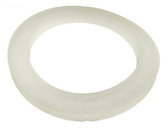
Quick Links
What's news, low flow spa heaters are back.
Great News. Many styles of Flow Thru and Low Flow Heaters are Back!Back in …
Baby it's cold outside.... How to avoid frozen spa pipes.
Hi Everyone,If you are like me, you are experiencing near zero temperatures. …
Not Sure What Part You Need? Send Us Photos at Our Contact Us Page.
If you are not sure how to identify what part you need, use our Contact Us Page …
Payment and Security
Copyright 2024 Spa Parts Guy . All Rights Reserved. Sitemap |
BigCommerce Partner : PSDCenter
All prices are in USD .
Selected For Comparision
Compare Now
Hot Tub Trips Breaker When Jets Are Turned On: 6 Reasons
Your hot tub is ideal for relaxing and unwinding, but that wouldn’t be the case if it kept tripping the breaker when the jets were turned on. These breaker trippings could be warnings of danger, which makes them more than just a nuisance. It could be dangerous, especially since water and electricity are involved.
If you are reading this, chances are you are having the same trouble some hot tub owners go through. Hottubs frequently experience GFCI problems, which are frequently easily fixed. However, before attempting to fix any electrical issues, be sure you know what you’re doing and the cause before providing a specific solution.
In this article, we will discuss why your hot tubs trip the breaker when the jets are turned on, so make you stick until the end.
What Is A Ground Fault Circuit Interrupter?
A GFCI breaker box, or ground fault circuit interrupter, is a device designed to secure your hot tubs from unexpected changes in your power supply. When electricity travels down a path other than the circuit’s designers intended, grounding faults and short circuits happen.�
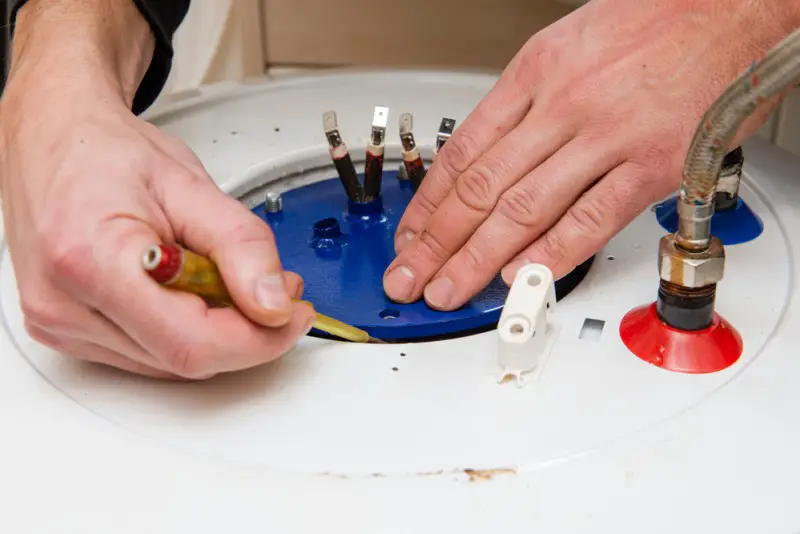
A GFCI interrupts the circuit and turns off all of the energy to your hot tubs when it notices an abnormality in the electrical supply, such as a ground fault condition or short circuit. It is frequently referred to as “tripping” the GFCI when this interruption takes place.
It is imperative to know where your GFCI breaker is located, as this would help determine the cause of any electrical issues in your spa. Your hot tub circuit breaker box will most likely be located in the control panel near or enclosing the hot tub outlet. The National Electrical Laws require that the GFCI breaker, be located at least six feet from your hot tub to decrease the likelihood of the electric system coming into contact with water.
6 Reasons Your Hot Tubs Trip The Breaker When Jets Are Turned On
When your circuit breaker trips, it clearly shows something wrong with your electrical supply. If it is a one-time reoccurrence, the simplest way to resolve this is to press the button that will reset the breaker. But when it repeatedly happens when your hot tub is turned on, and your jets are working, you have to start ruling out the possible causes as to why this happens.
Here are 6 possible reasons it trips the circuit breaker when your jets and hot tub are turned on.
1. Exposure To Moisture
You may experience frequent breaker trippings if there is moisture within the control box where it is located. These boxes are susceptible to condensation or rain-related moisture. In such a case, the moisture inside the control box may start harming the electrical components. If this happens, it is essential to replace broken components and ensure that the circuit box is sheltered from additional moisture.
2. Ground Fault Problem
The GCFI breaker has a lot to do with the electric connections in your hot tub. When the quantity of electricity load varies unusually, the GFCI circuit breaker activates. For a few reasons you might experience issues with the GFCI circuit breaker frequently tripping because of the following reasons.
- The GFCI has issues that are causing them to malfunction.
- Issues with a spa part or parts, like a heater or pump
- Incorrect GFCI wiring that needs to be fixed.
3. Short Circuits
This is a common problem among many home appliances, not just the hot tub. If this is the cause, a quick solution is necessary to avoid fire and electrocution. Over time, the wires in your hot tub may come into contact with one another, causing a surge in electricity all through the circuit and possibly even burning the wiring. This will most likely trip any breakers to minimize the damage caused by the burst.
A ground fault occurs due to wiring similar problems to short circuits. The main difference is the direction of the current. In this case, it contacts the ground, causing a fault and tripping the breaker.
4. Corrosion
Any damp area is prone to rust. This can corrode the wirings, connectors, ground wires, control panel of a hot tub, and other electrical components, leading to hot tub tripping.
Before examining issues inside your hot tub involving electricity, it is important always to cut off the primary electrical supply and never stand in the water or handle any wet objects.
Look for symptoms of corrosion, such as rust or white powder, when you open the electrical box. Then examine each component with a flashlight. A brush can be used to remove minor rust. In serious cases, you will probably need the help of the experts.
5. Loose Electrical Connections
The electric connections in your hot tub can become loose over time. Power fluctuations cause your Hot Tub’s circuit breaker to trip. Knowledgeable electricians will thoroughly check your Hot Tub and ensure security in any loose connections that may be causing the breaker to trip.
If this is the cause, it can be simply fixed. Loose connectors are relatively simple to repair. To maintain the wires in place, you may need to utilize a screwdriver to ensure the security of the screws inside your Hot Tub Spa Pack. Give them a quick push to ensure that the plastic plugs are secure. Any missing or broken connectors will also need to be patched.
6. Bad Heating Element
Your Hot tub’s heating element is one of the most commonly at-fault hot tub components. The heater component for your spa is made of a metal tube with a heating coil inside. To be heated, the hot tub water flows through the housing. The water won’t heat up if the coil isn’t hot. The hot tub breaker will then trip when something prompts the element to malfunction.
If this is the issue, turn off the heater’s breaker by flipping the switch. You might need to repair or replace the heating element if the breaker box does not trip when the heater is disconnected.
Frequently Asked Questions
Here are some frequently asked questions to guide why hot tub GFCI breaker trip when the jets are turned on.
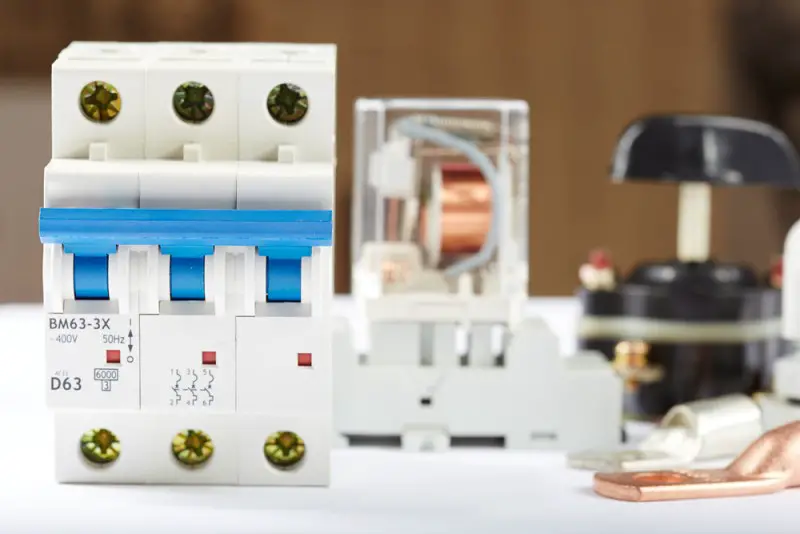
Why Won�t My Hot Tub Breaker Stay On?
It could be something minor, like a bad connection and overloading, or it could be something much more dangerous. The most likely causes include short circuits, grounding faults, moisture exposure, malfunctioning GFCI outlets or breakers, rust and heat damage, and broken tub components.
Why Does My Hot Tub keep Kicking The Breaker?
Sparks, popping noises, or smoke are all signs of a short circuit and should always trigger a breaker to trip and kick or a fuse to burst. A loosened wire, a faulty connection, or even damage from mice or squirrels nibbling on cables could be the source of the problem.
Should I Be Worried If My Hot Tub Breaker Keeps On Tripping?
Don’t disregard a tripping circuit breaker. This indicates that one of the circuits is frequently overloaded. Your circuits can only handle a certain amount of voltage. You risk starting an electrical problem or fire if you exceed this voltage.
A hot tub breaker that keeps kicking when you turn the hot tub on or when the jets are working indicates a problem with electrical connections in your hot tub. Make sure that you have the right diagnosis for the problem. It could be among the 6 reasons stated above. Consult the experts to handle the problem for you. You might not want to do it alone, especially since mishandling it can lead to fire and other electrical problems.

How Much Does It Cost To Remove A Hot Tub?
How To Cool Down A Hot Tub In Summer

This site is reader-supported, and we earn commissions if you purchase products from retailers after clicking on a link from our site. As an Amazon Associate, I earn from qualifying purchases.
How Can Our Hot Tub Bud Team Help You?
? 2024 Hot Tub Bud | Privacy Policy
Hot Tub Trips Breaker When Jets Are Turned on
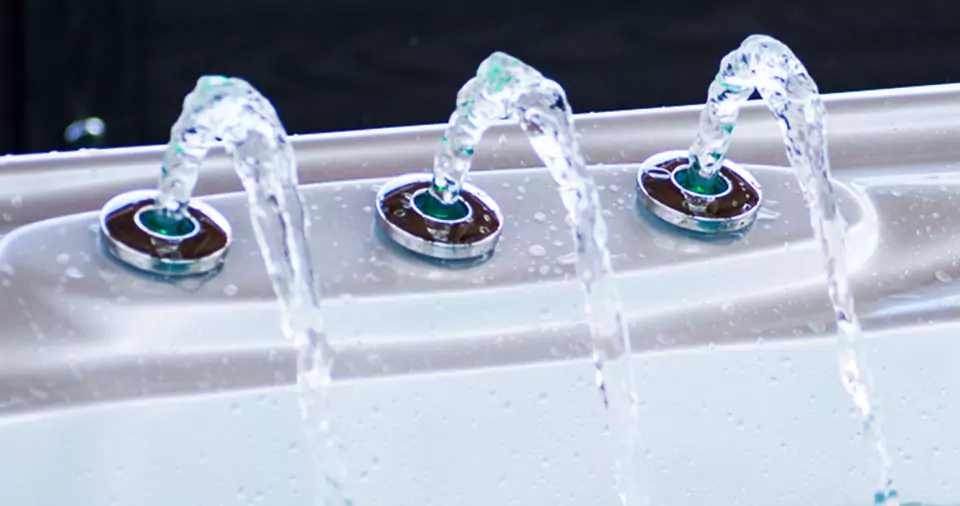
Hot tubs are a great way to relax and unwind, but nothing can be more frustrating than when your hot tub trips the breaker as soon as you turn on the jets. This problem not only affects the hot tub’s performance but can also be dangerous if left unresolved. Thus, it is crucial to understand the reasons why hot tubs trip breakers and how to troubleshoot the issue.
The GFCI circuit breaker keeps tripping, shutting off the power to your spa just when you are settling in for a soak. This article aims to provide comprehensive information on why hot tubs trip breakers and how to prevent it from happening. We will discuss the common causes of hot tub tripping breakers, how to troubleshoot the problem, and tips on how to prevent it. So, if you are a hot tub owner experiencing this problem, or you are thinking of buying one in the future, read on to know how to handle this common issue.
- Key Takeaways
- A tripping circuit breaker in your hot tub can indicate an underlying issue that needs to be addressed.
- Overloading the circuit, damaged wiring, water leakage, dirty or clogged filters, faulty pump or heater, and faulty GFCI are some of the common reasons why a hot tub may trip the breaker.
- Regular maintenance, inspections, and repairs can help prevent these issues and ensure a safe and enjoyable hot tub experience.
- Prioritize safety when dealing with electrical issues and always seek help from licensed professionals when in doubt.
Why Hot Tub Trips the Breaker When Jets Are Turned On?
What’s gfci breaker, 1. overloading the circuit, 2. damaged wiring, 3. water leakage, 4. dirty or clogged filters, 5. faulty pump or heater, 6. faulty gfci, troubleshooting hot tub tripping breakers, how to prevent hot tub breakers from tripping, final thoughts.
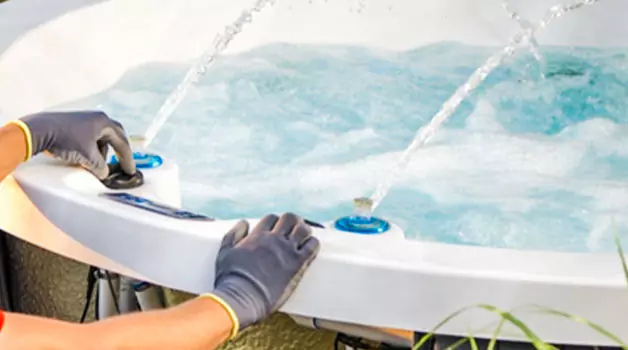
If your hot tub trips the breaker when you turn on the jets, there could be a few different reasons for this issue. One possible cause is that the motor that powers the jets is drawing too much current and overloading the circuit. This could be due to a faulty motor or a problem with the wiring.
Another possible cause of the issue is a clogged or dirty filter. When the filter is dirty, it can restrict water flow and cause the motor to work harder, which in turn can cause it to draw too much current and trip the breaker.
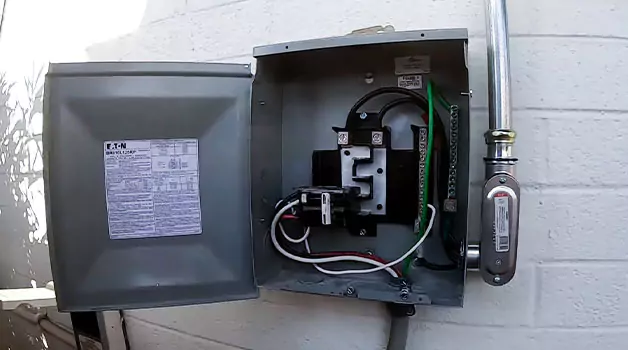
As you are getting ready to relax in your spa, the GFCI circuit breaker suddenly trips, causing the power to shut off. This unexpected interruption can be frustrating, especially when you are looking forward to unwinding after a long day.
The Ground Fault Circuit Interrupter (GFCI) is designed to protect you from electrical shocks and short circuits. It constantly monitors the amount of electricity flowing through the circuit and trips the breaker if it detects any imbalance or leakage. This safety feature is essential for preventing electrical hazards, but it can also cause inconvenience if it trips frequently.
There could be several reasons why your GFCI circuit breaker is tripping, such as a faulty appliance, water leakage, or a damaged wire. It’s essential to identify the root cause of the issue to prevent the problem from recurring.
One common reason for GFCI tripping is a faulty appliance, such as a pump or heater, which can cause a ground fault. Another possibility is water leakage, which can cause electrical currents to flow where they shouldn’t. In some cases, a damaged wire or connection may be the culprit.
6 Reasons Hot Tub Trips the Breaker
If you are a hot tub owner, you may have experienced the frustrating issue of the circuit breaker tripping repeatedly. This not only interrupts your relaxation time but also indicates an underlying issue that needs to be addressed. Here are six possible reasons why your hot tub is tripping the breaker, along with detailed explanations:

Your hot tub may be overloading the circuit, causing the breaker to trip. If your hot tub’s electrical requirements exceed the circuit’s capacity, it can cause the breaker to trip frequently. You can check the electrical rating of your hot tub and compare it to the rating of the circuit breaker to ensure they match. It’s also advisable to have a licensed electrician inspect your wiring and electrical setup to confirm they are safe and up to code.
If the wiring in your hot tub is damaged, it can cause a short circuit, which can trip the breaker. Damaged wiring can also pose a safety hazard, so it’s essential to have it fixed as soon as possible. Check for any signs of frayed or exposed wires, and if you notice any damage, do not attempt to repair it yourself. Instead, call a licensed electrician to assess the damage and make necessary repairs.
Water leakage in your hot tub can cause electrical currents to flow where they shouldn’t, leading to a ground fault and tripping the breaker. Regular maintenance and inspections can help prevent water leakage. Inspect the hot tub shell, pipes, and connections for any signs of water leakage, such as wet spots or discoloration. Also, make sure the hot tub cover is in good condition and properly secured to prevent water from seeping in.
Dirty or clogged filters can restrict water flow, causing the motor to work harder and draw more power, leading to the breaker tripping. Regularly cleaning and replacing the filters can help prevent this issue. Check your hot tub manual for specific filter maintenance instructions and follow them accordingly. Generally, you should clean the filter every two to four weeks and replace it every six to twelve months.
A faulty pump or heater can cause a ground fault, leading to the breaker tripping. Regular maintenance and inspections can help identify and fix these issues. If you notice any unusual noises, vibrations, or poor performance from your pump or heater, it’s best to have a licensed hot tub technician inspect it. They can identify and fix any issues before they cause more significant problems.
If the Ground Fault Circuit Interrupter (GFCI) is faulty, it can trip the breaker, even if there’s no ground fault. A licensed electrician can help diagnose and fix this issue. GFCIs are essential safety features that protect against electrical shocks and should be regularly tested and maintained. Follow the manufacturer’s instructions to test your GFCI regularly, and if you notice any issues, call a licensed electrician immediately.
If your hot tub is tripping the breaker, there are several steps you can take to troubleshoot the problem:
- Check for water flow issues: Low water levels or clogged filters can cause the hot tub to overheat, which can trip the breaker. Make sure the water level is adequate and clean or replace the filters if needed.
- Examine the electrical system: Inspect the hot tub’s electrical system for signs of damage, wear, or loose connections. Pay special attention to the pump, heater, and control panel.
- Identify and replace faulty hot tub parts: If you find any damaged or worn-out parts, it is best to replace them. Faulty parts can cause the hot tub to trip the breaker repeatedly.
- Reset the breaker: If you have identified and resolved the root cause of the problem, you can reset the breaker by turning it off and then back on again.
Following safety precautions vary essentially working with hot tub electrical systems. If you are not comfortable or knowledgeable about working with electricity, it is best to contact a professional to solve the problem.
✨ You May like: How to Lower Alkalinity in Hot Tub Without Affecting PH?
Preventing hot tub breakers from tripping is essential to ensure your hot tub’s proper functioning and safety. There are some tips to help you prevent hot tub breakers from tripping. These tips can prevent hot tub breakers from tripping and ensure your hot tub’s longevity and safety. In the next section, we will provide answers to some frequently asked questions about hot tub tripping breakers.
- Regular hot tub maintenance: Regular maintenance of your hot tub can prevent many problems, including tripping breakers. Clean the filters regularly, maintain the water chemistry, and ensure the water level is adequate.
- Understand the hot tub’s electrical needs: Understanding the electrical requirements of your hot tub can help you prevent overloading the circuit. Check the hot tub’s manual for the recommended circuit size and make sure it is compatible with your home’s electrical system.
- Tips for using your hot tub: Avoid using high-powered devices, such as hairdryers, while the hot tub is running. Also, avoid turning all jets on at once, as it can overload the circuit.
1. What should I do if my hot tub keeps tripping the breaker?
Check for water flow issues, examine the electrical system, identify and replace faulty hot tub parts, and reset the breaker. If you are not comfortable working with electricity, contact a professional.
2. Can I replace a hot tub breaker myself?
It is best to contact a professional if you need to replace a hot tub breaker. Working with electricity can be dangerous if you are not experienced or knowledgeable.
3. How often should I have my hot tub inspected?
It’s recommended to have your hot tub inspected by a licensed technician at least once a year to ensure its safe and efficient operation.
4. Can I still use my hot tub if the breaker keeps tripping?
No, it’s not safe to use your hot tub if the breaker keeps tripping. Continuing to use the hot tub may pose a safety hazard and cause more significant problems. Have a licensed professional inspect and repair the underlying issue before using the hot tub again.
Hot tubs can be a great way to relax and unwind, but they require careful maintenance and attention to ensure their proper functioning and safety. If your hot tub is tripping the breaker, it is essential to identify and resolve the root cause of the problem to prevent it from recurring.
The following tips outlined in this article can explore and prevent hot tub breakers from tripping, ensuring your hot tub’s longevity and safety. Remember to always follow safety precautions when working with hot tub electrical systems and contact a professional if you are not comfortable or knowledgeable about working with electricity.
✨ Next Attraction: Are Backyard Fire Pits Legal?

Donald Beyer
I am Donald M. Beyer and I am backyard enthusiasts. I am a homeowner who has been doing DIY projects in and out of my house for many years. From simple backyard lunches to making an old-school pizza oven in my own backyard, I have a lot of experience in turning my backyard into my and my family’s personal playground.
- Donald Beyer https://backyardaim.com/author/donald-m-beyer/ Can I Put A Hot Tub In My Summerhouse?
- Donald Beyer https://backyardaim.com/author/donald-m-beyer/ Can You Put A Hot Tub In A Metal Shed?
- Donald Beyer https://backyardaim.com/author/donald-m-beyer/ What do you wear to a hot tub party?
- Donald Beyer https://backyardaim.com/author/donald-m-beyer/ How To Decorate A Hot Tub Area For A Party?
Related Posts

Do I Need A Permit For An Above-Ground Pool?

How To Clean An Automatic Pool Cover?

11 Hot Tub Brands To Avoid

Why Are Hot Tub Covers So Expensive?

Top 10 Best Above Ground Pool Skimmer In 2023
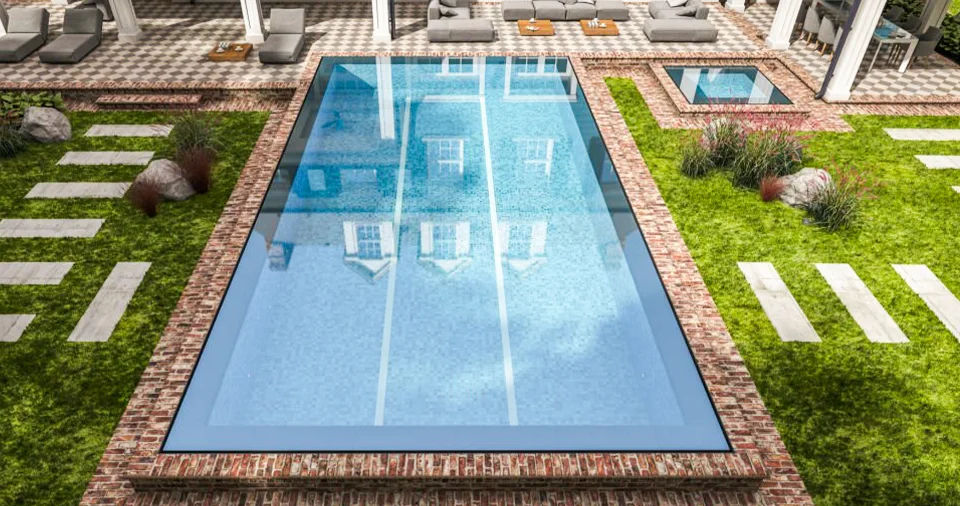
Rectangular Pool With Hot Tub
Leave a comment cancel reply.
Your email address will not be published. Required fields are marked *
Save my name, email, and website in this browser for the next time I comment.


IMAGES
VIDEO
COMMENTS
The hot tub water passes through the housing to be heated. If the coil isn't hot, the water won't heat up. If something is causing the element to malfunction, the hot tub breaker will trip. Bad Heating Element: Disconnect the heater from the breaker, and flip the breaker switch.
1. Worn GFCI Breaker. One of the most common reasons for a hot tub breaker to trip is that it is simply worn out. Old age, power surges, and a lightning strike are just a few reasons why your ground fault circuit interrupter (GFCI) breaker is tripping. To identify a worn GFCI breaker, flip the switch off and on.
6. Corroded electrical components. Corrosion can wreak havoc on your spa's electrical system. So if your hot tub's components appear rusty, that might be why your breaker trips randomly. The primary reason why this happens is that hot tubs produce massive amounts of steam, and are also often exposed to the elements.
Faulty Heater. A faulty heater can also cause the breaker to trip. If the heating element in your hot tub has a short circuit, it will draw excessive power, causing the breaker to trip. To check if your heater is the issue, disconnect it and see if the electricity still trips. If it does not, then the heater is faulty.
There may be an issue with your GFCI. Disconnect all hot tub components from your GFCI, then reset it. If it immediately trips even though nothing is attached to it, your GFCI is most likely faulty and will need to be replaced. There may be an issue with one of your hot tub's components, such as the heater, the pumps, or the entertainment system.
If it does not trip this time, there is a problem with something you usually plug into the breaker, like a heater, pump, or hot tub component. If it does trip again, the breaker itself has gone bad and will have to be replaced by a qualified electrician. Ask whether a power surge caused the problem and if so, inquire about surge protector ...
Water Leaks: Water and electricity don't mix well. If there's a leak in your hot tub's plumbing or electrical components, it can lead to short circuits and trip the breaker as a safety precaution. Faulty Heating Element: A malfunctioning heating element can cause excessive power usage, leading to breaker trips.
Reason #2: Moisture. Moisture could also be a reason your circuit breaker is tripping. If it's an outdoor hot tub, then you could have moisture problems which can be causing it to trip. A hot tub cover can be helpful when the unit is not in use. Leakages from some plug and play hot tubs can also cause moisture problems.
A: In some cases, repeated breaker tripping may indicate the need for an upgrade to your hot tub's electrical system. Potential causes include an overloaded circuit, a bad heating element, or issues with the non-return valve. Upgrading the system and possibly installing a new breaker can help alleviate the problem.
If there is moisture in the Hot Tub circuit breaker's control box, this will cause the switch to trip frequently. Moisture and water cannot be present across a circuit. Moisture on the live or bridging the live and the neutral connections will cause the circuit to trip. Condensation, water or moisture from rain can penetrate into these boxes ...
Your hot tub might be tripping the breaker due to a worn out GFCI breaker, moisture in the breaker box, a build up of corrosion, damaged wiring, component issues, or a flooded air blower or ozonator. Electrical issues with a hot tub should be addressed as soon as possible to avoid damage or injury. Luckily, many of these issues can be addressed ...
If you find that your hot tub trips the GFCI breaker at seemingly random times, use a process of elimination to determine what is causing the power outage. Check your outlet and make sure the plug is firmly inserted. First, disconnect everything from the GFCI breaker. If it still trips that tells you the problem in with the breaker itself.
3-The common issue of hot tub tripping the breaker How To Guide: Addressing Common Hot Tub Breaker Tripping Issues. 1. Turn off the power supply: Always switch off the main power supply before inspecting any electrical components. 2. Visual inspection: Look for signs of wear and tear, such as a cracked or broken switch.
A hot tub provides excellent relaxation and therapeutic benefits, but in the rare situation that your circuit breaker is tripping, it's important to understand what steps can be taken to resolve it. Here are five easy fixes you can apply when your hot tub is tripping your circuit breaker: 1. Get Rid of Any Moisture in the Breaker Box
Another issue that can result from bad installation involves loose electrical connections. If connections in your hot tub are loose, it could cause significant fluctuations in power, which can trip the breaker. 3. Moisture Within the Breaker Itself. If there's moisture within the breaker itself this will result in the breaker tripping at ...
When your hot tub trips the breaker, one of the things to consider is if there might be circuit interruptions caused by loose wiring. Because of old age or being moved around for any reason, electrical connections can eventually come loose. Power fluctuations are then unavoidable, which can result in your hot tub tripping the breaker. ...
When your hot tub trips the breaker when the jets are on, it's typically due to an electrical overload. Jet pumps draw substantial power, and issues like a faulty pump, clogged jets, or electrical problems can lead to this. To ensure safety and proper function, consult a qualified technician for diagnosis and repair.
For Spa Service Technicians and Home Owners alike, one of the most common Hot Tub problems, is a GFCI Breaker that trips and will not reset. Many people make the mistake of calling their Electrician first and costing them a wasted service call fee. Or they rush out to the Big Box Store and plunk down a hundred bucks for a new GFCI Breaker, only to find out, once installed the new Breaker still ...
If the breaker trips, even with nothing connected to it, you need to replace the breaker. Reason 2: Moisture in your Hot Tub Breaker Box. Pop open the breaker box, shine the flashlight around in there, and see if you find any moisture inside. Rainwater, splash out, or flooding can introduce enough dampness to flip a hot tub GFCI.
The most likely explanation for your hot tub's sudden breaker tripping is that the breaker is broken. Breakers may need replacing for several reasons. These include age, electrical fluctuations, and even storm damage. Luckily, testing for a malfunctioning breaker is a simple process.
Here are 6 possible reasons it trips the circuit breaker when your jets and hot tub are turned on. 1. Exposure To Moisture. You may experience frequent breaker trippings if there is moisture within the control box where it is located. These boxes are susceptible to condensation or rain-related moisture. In such a case, the moisture inside the ...
So, turned off breaker, drained the tub, refilled it and turned breaker on - no power. After investigating, I found the GFCI breaker is tripped. It trips immediately each time I try to turn it on. I found some discussion about troubleshooting GFCI problems. I unplugged various components 1 by 1 but it still trips.
Why hot tub trips the breaker when jets are turned on. If your hot tub trips the breaker when you turn on the jets, there could be a few different reasons for this issue. One possible cause is that the motor that powers the jets is drawing too much current and overloading the circuit. This could be due to a faulty motor or a problem with the ...